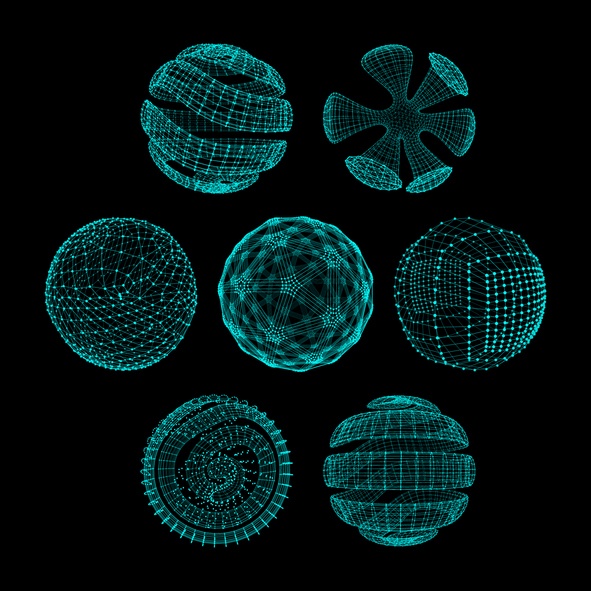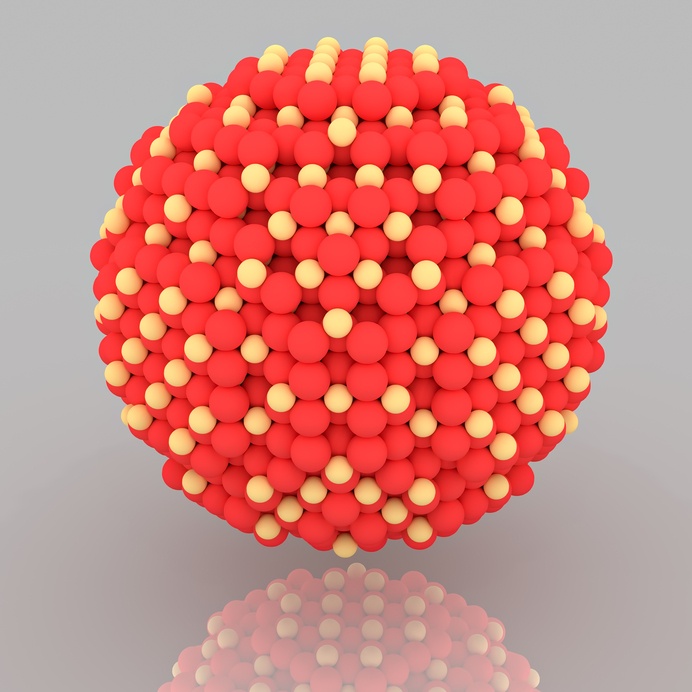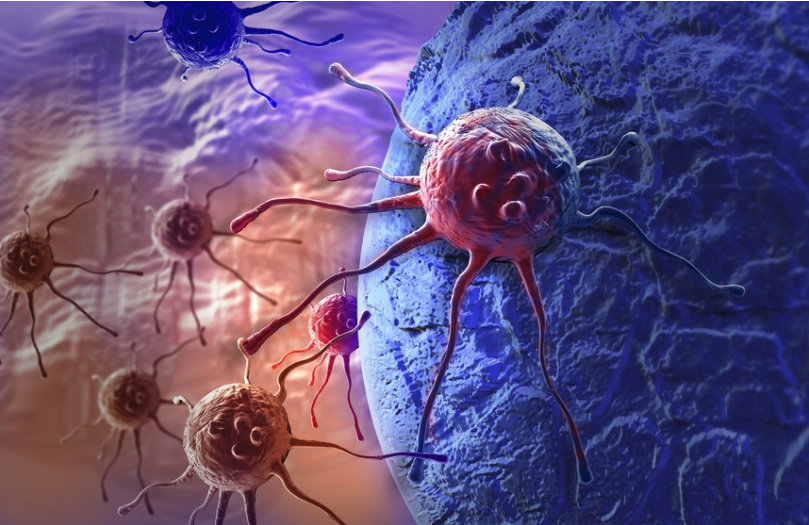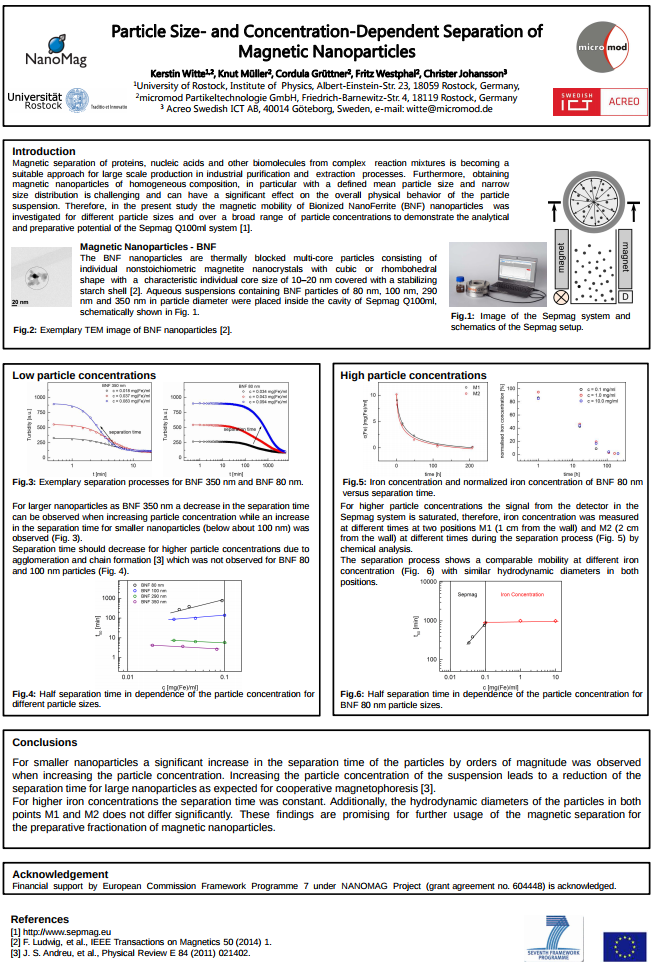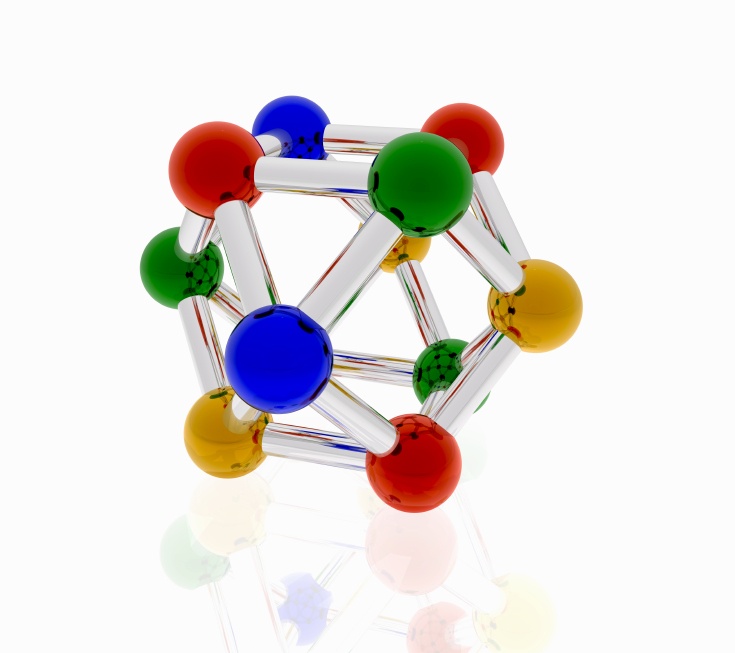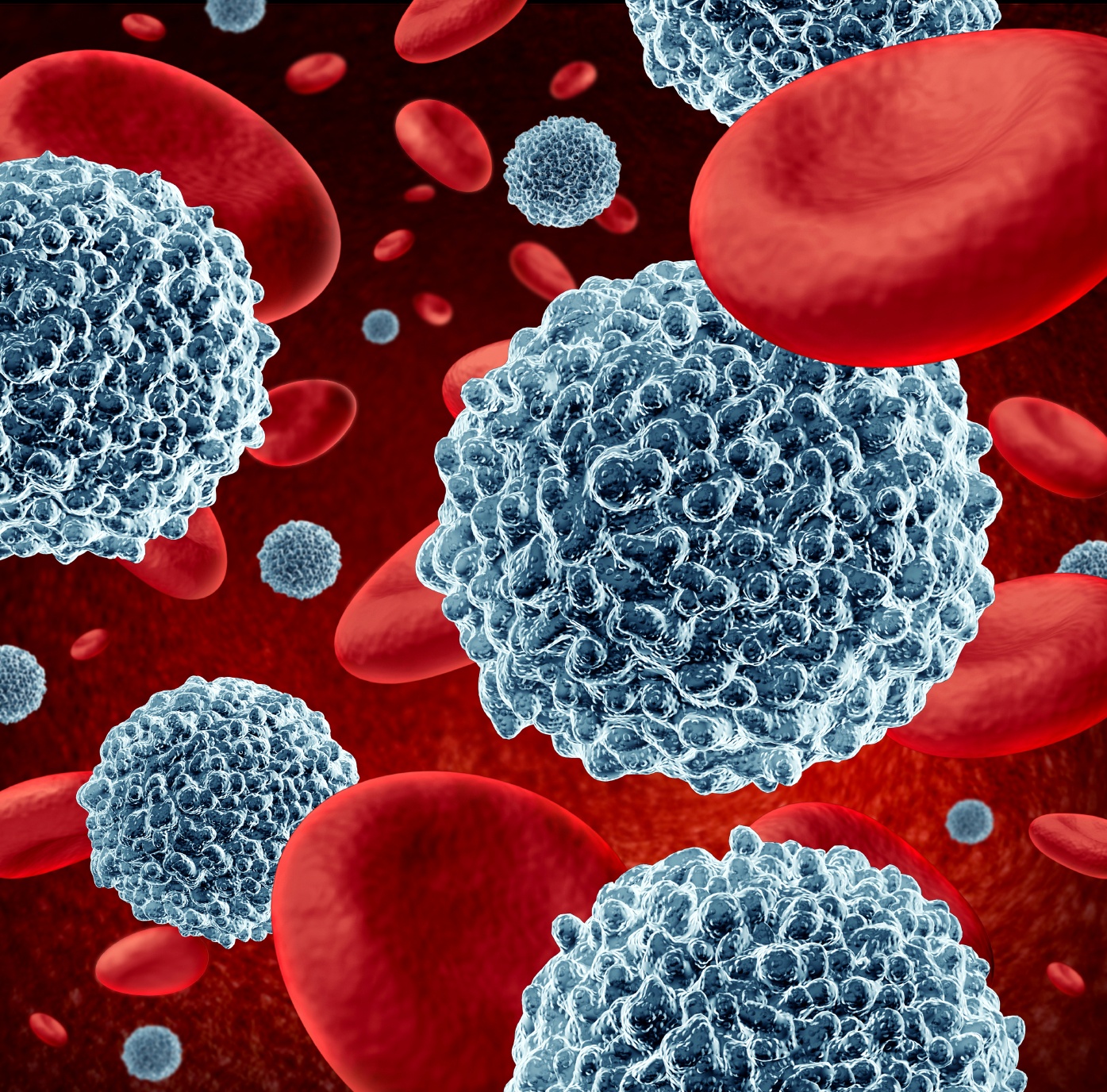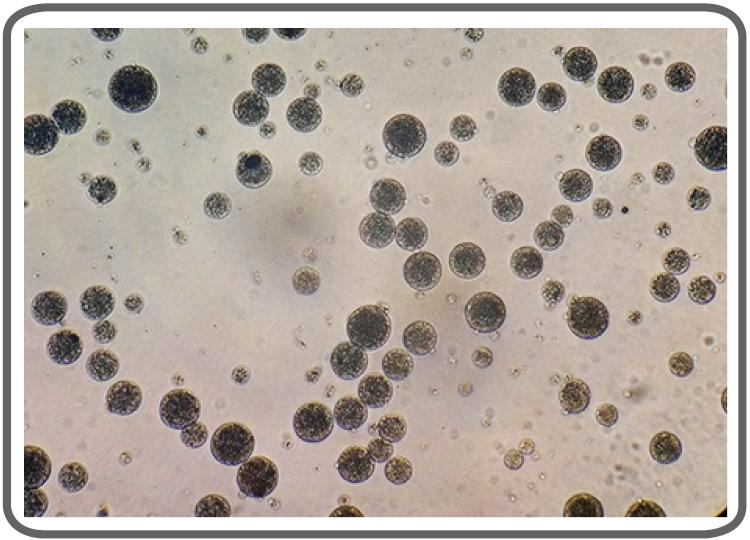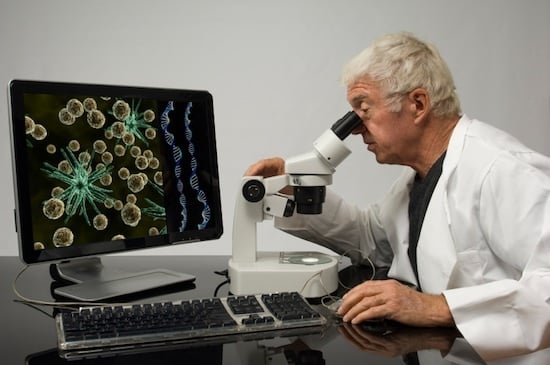Nano gold is another name for gold nanoparticles. These nanoparticles are a fraction of the size of human hair and are less than 100 nm in diameter. Nano gold particles are so small that it they are generally found as a colloidal solution, which means that the gold nanoparticles are suspended in a liquid buffer. Therefore, nano gold, or gold nanoparticles are also called colloidal gold. Also, nano gold is generally found in a colloidal solution because gold nanoparticles are created by citrate synthesis. This process involves mixing solutions together to result in the precipitation of gold nanoparticles into solution.
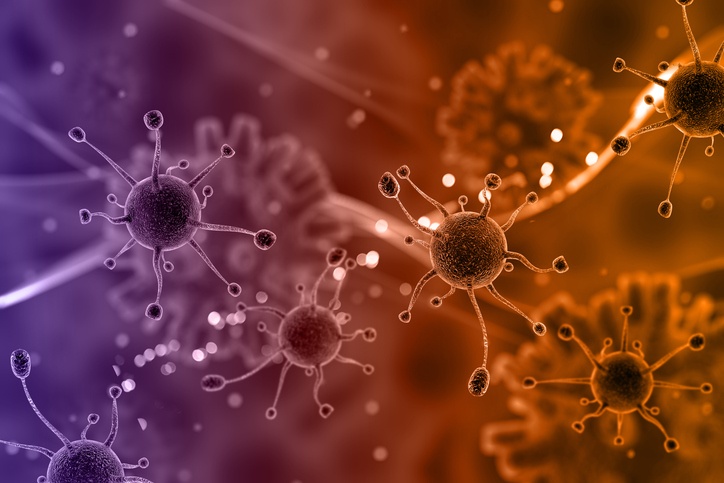
Magnetic beads and separators have grown in popularity as a biotechnological tool over the past few decades. As we gained experience with the technology, we learned that all magnetic separators are not created equal. It turns out that it isn’t just the magnitude of the magnetic force that improves separation time, it is the way it spreads out over the working area that matters the most. A homogeneous magnetic separator is designed to ensure that every point within the working volume experiences the same magnetic force. This is especially important when scaling up a biomagnetic separation process from milliliters to liters.
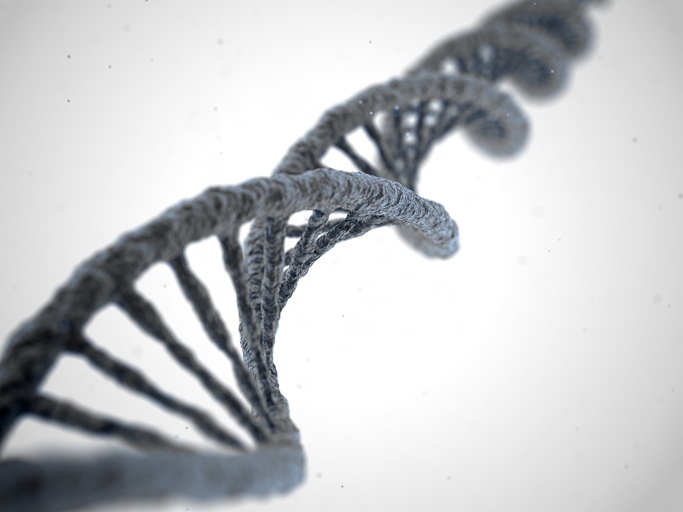
The collection of tissue is a fundamental procedure for research and clinical biology. Before collection it is important to consider which method will be used to preserve the tissue and prepare it for histology or molecular analysis. There are two options to choose from when collecting and preserving tissue: frozen or formalin-fixed paraffin-embedded (ffpe). Each has its strengths and weaknesses, but these are only apparent when the intended use of the tissue is considered.
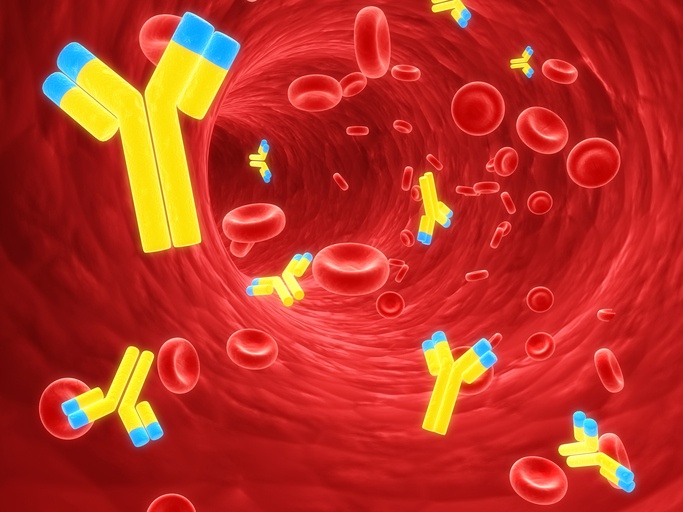
Anti human IgG is the most prevalent antibody isotype in human serum. It plays a critical role in the adaptive immune response. When a pathogen invades a human body it is intercepted by a white blood cell called a B-cell. These B-cell lymphocytes have cell surface receptors that bind a wide array of pathogens. Once activated, the B cell divides and produces offspring cells which secrete very specific antibodies capable of identifying that exact invading pathogen. These antibodies recognize a specific antigen binding site.

The synthesis of complementary DNA (cDNA) is fundamental to the study of RNA expression in cells and tissues. RNA is fragile and not compatible with the polymerase chain reaction (PCR). Therefore, an intermediary step is needed to convert RNA to cDNA for analysis by quantitative PCR (qPCR). This qPCR technique utilizes specific primers and polymerase enzyme to amplify targeted sequences of cDNA. Since the cDNA is complementary to the initial mRNA isolate, this technique provides a quantitative readout of mRNA levels in the sample. The need for cDNA is so great that many companies sell cDNA synthesis kits to simplify the procedure.

We are all familiar with magnetic materials, but not so much with what exactly ‘magnetic’ means. The magnetic moment, usually quoted as ‘m’, it is defined as the property that makes a material align with an external magnetic field.
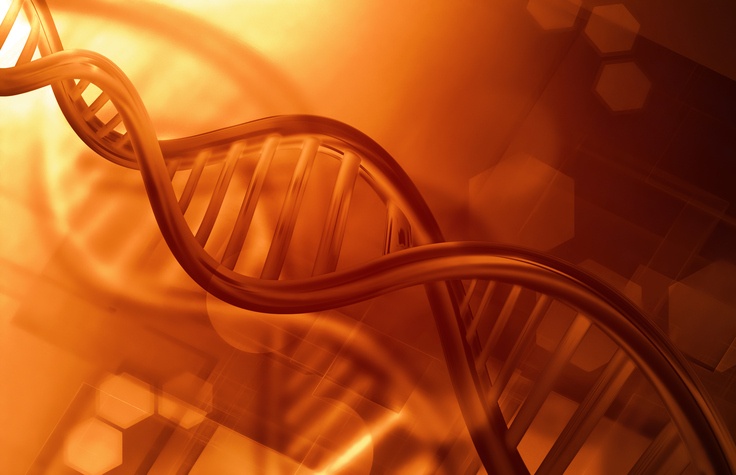
A CHIP assay is short for Chromatin Immunoprecipitation assay. This technique is used to gain insight into the region of the genome a particular protein is associated with. To do this the CHIP assay captures information about the protein-DNA interactions in the histones of genomic DNA. The protein-DNA binding structure is preserved because the histone is crosslinked before the cell is lysed. The protein and DNA are bound together even after the chromatin is broken up into smaller pieces. Then the protein-DNA conjugates are captured by immunoprecipitationwith antibodies binding specifically to regions in the protein of interest. Then the DNA is extracted from the proteins and analyzed by targeted qPCR or genome-wide next-generation sequencing (NGS).

Biotinylation is the process of attaching a biotin tag to a molecule. The molecule can be a protein or an oligonucleotide. Biotinylated molecules are useful in many biological contexts, but are primarily used for capture or detection of target molecules. Biotinylated molecules are used in Western blotting, ELISA, flow cytometry, and other inventive detection methods.
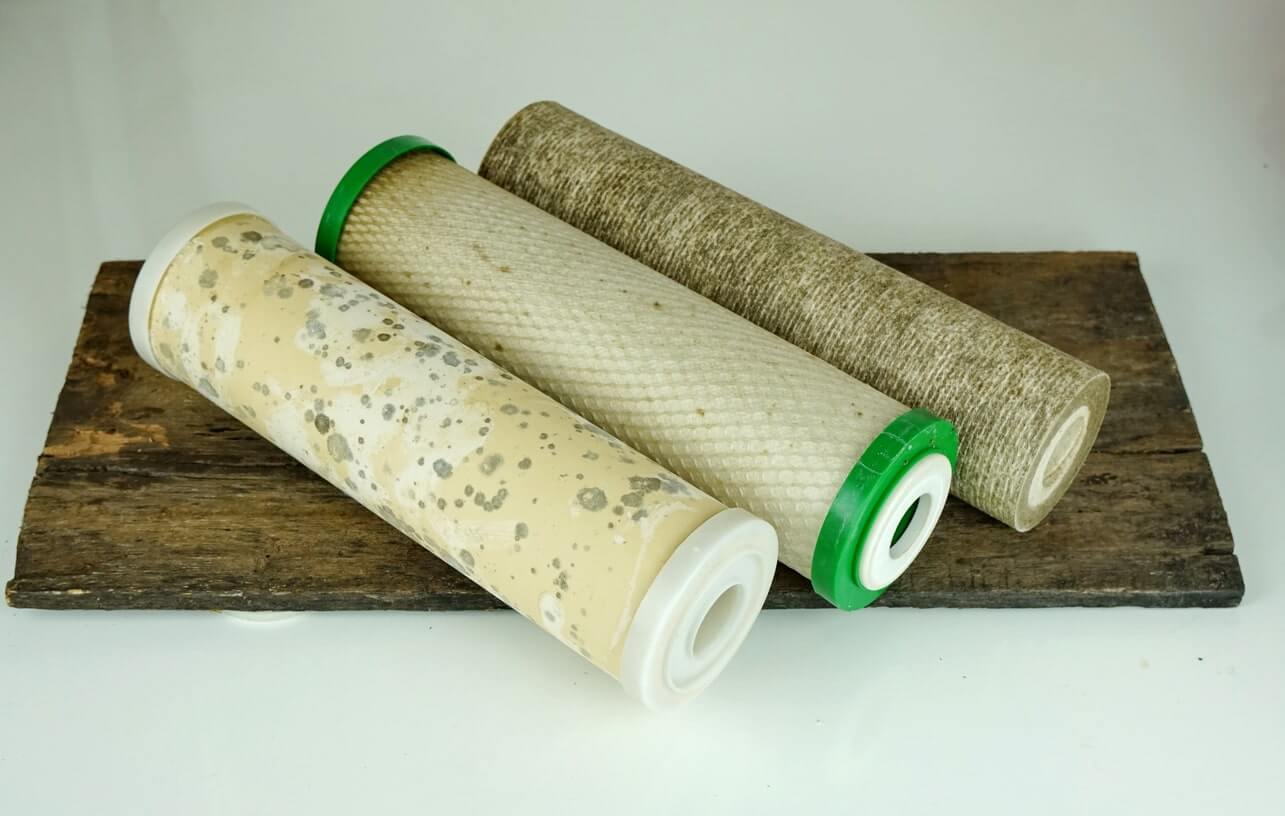
Filtration is a common technique for mechanically separatinggases or liquids. A filter membrane serves as a barrier to enable ion exchange, removing macromolecules or bacteria from solution, separating colloids, or recovering gases. Some uses for filtration include producing clean drinking water, generating safe food products, and ensuring a clean environment. It is used for petro-chemical vapor recovery, oxygenation of blood in an artificial lung, and hemodialysis via an artificial kidney. Filter membranes are necessary for ion exchange in a fuel cell and for electrolysis. Filtration is also a key procedure in the laboratory to separate RNA, DNA, cells, proteins, and other molecules.
Common methods include microfiltration (0.1 to 1 micrometer particulates), ultrafiltration (0.001 to 0.1 micron), nanofiltration (less than 0.001 micron), and reverse osmosis (less than 0.001 micron). Microfiltration is used to separate colloidal solutions, but the other three are used for dissolved particulates.
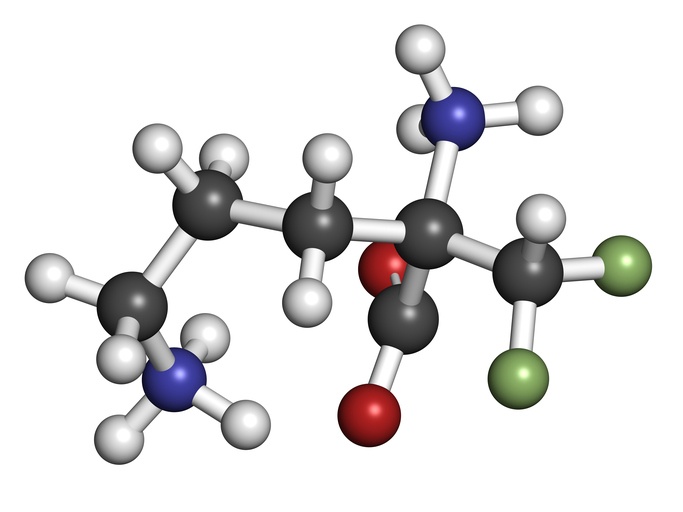
Enzyme immobilization onto solid supports is a convenient way to control and reuse enzymes. The enzyme is a catalyst for a reaction, meaning that it enables or speeds up the chemical conversion from reactants to products. This is a valuable property for both small scale research and large scale industry including biotechnology, pharamaceutical applications, food production, and wastewater treatment. There are many materials used for immobilized enzyme solid support systems, and a variety of enzymes can be used. Perhaps the most advantages solid support system is one that is magnetic. A magnetic bead is easily recoverable with the application of an external magnetic field. This ensures that reusing the enzyme is quick and easy.
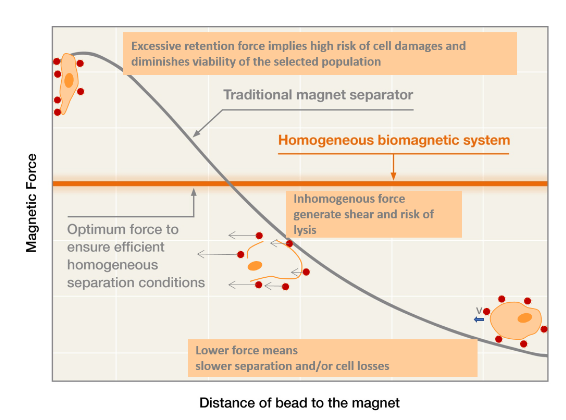
The traditional biomagnetic separation is a permanent magnet block. The test tube is placed next to the magnet and the magnetic particles in solution move toward the magnet. This system works for very small volumes, but it is not the most efficient method and problems often arise in larger volumes. The downfall of this geometry is that the permanent magnet is only on one side of the tube, which means that the magnetic particles are only drawn to that one side. The magnetic particles close to the magnet will experience a higher force than the magnetic particles farthest away from the magnet. Magnetic force decreases as distance from the magnet increases, so the particles farthest away might not feel any force if the magnetic strength is not great enough.

Centrifugation is a common technique used for the separation of heterogeneous mixtures. The force of gravity on matter is the core principle of centrifugation. Matter naturally separates based on density, with the most dense particles precipitating out of solution first, and the less dense particles falling out later. Some particles prefer to remain in colloidal solution under normal gravitational force, and will not separate naturally within a reasonable time frame.Centrifugation can be used to rapidly separate those mixtures. The spinning centrifuge creates centripetal forces much greater than gravity, which can force particles to separate. The centrifugal protocol must be optimized for each experiment in order to efficiently separate the mixtures into desired layers. The most basic separation results in a higher density pellet at the bottom of the tube, and a lower density supernatant. Differential centrifugation is a process whereby the pellet and supernatant are separated during multiple centrifugation steps. Density gradient centrifugation utilizes a density gradient matrix within the tube to aid in separation. Another useful tool for centrifugation is a centrifugal filter. The filter helps to separate particles by size as well as density in one swift motion. The centrifugal filter is used to isolate RNA or DNA, to consolidate proteins, to separate molecules by size, or to remove contaminants from a liquid.
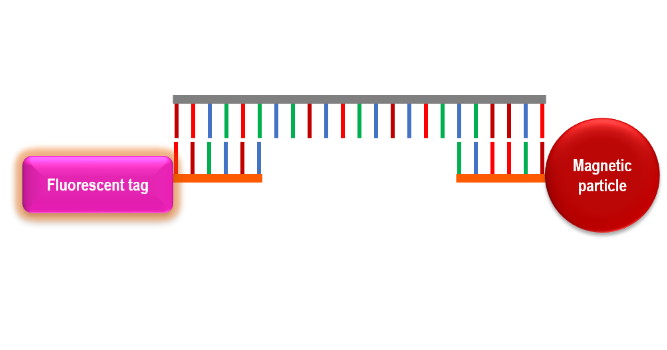
The reversible-binding systems mentioned in the previous post are examples of non-specific capture methods. They capture total DNA and RNA in a sample because they simply rely on the affinity of nucleic acids to the magnetic particle coating or functional moiety. Non-specific capture methods bind all single-strand (ssDNA) or RNA regardless of sequence. A more specific capture system is able to target specific sequences of ssDNA or RNA. This type of specific capture is most applicable to diagnostic systems as an assay for a specific pathogen. Examples include systems to diagnose methicillin resistant staphyloccocus aureaus (MRSA), specific plant viruses, and infection with malaria-causing bacteria. These strategies could be applied to detect viral, bacterial, or fungal pathogens in a variety of clinical samples.
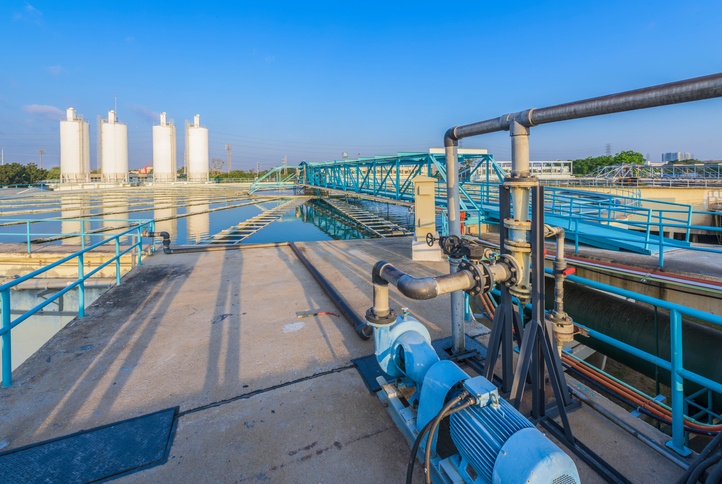
Cleaning validation is an important regulatory component of industrial manufacturing. It ensures that a standard and reliable protocol is followed forthe removal of residual chemicals from equipment between batches. Clean equipment is important for process validation because consistent products cannot be synthesized without consistent starting points. However, cleaning validation is about more than just equipment cleaning. Attention must be paid to other parts of the manufacturing process including employee education, building and facility maintenance, equipment calibration and maintenance, control of raw materials, up-to-date standard operating procedures, clear communication between all employees, and accurate reporting of data and processes.
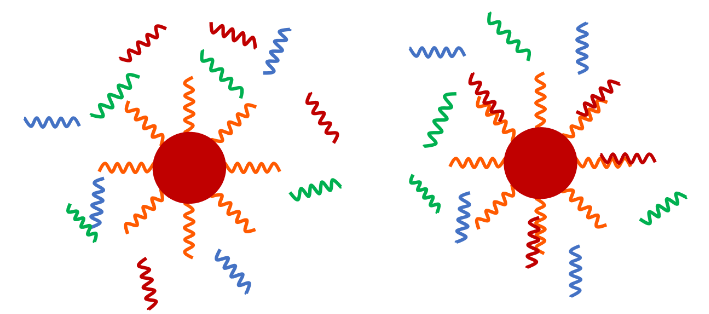
The coating and surface chemistry of magnetic beads governs the binding efficiency of target DNA or RNA. Superparamagnetic beads for life science applications come in two general forms: core-shell type and embedded type. The core-shell synthesis method produces beads composed of a single superparamagnetic core with a polymer or silica surface coating. One example is a bead composed of a magnetite core surrounded with a dextran shell. Other beads of the core-shell type are composed of a polystyrene or polyvinyl alcohol (PVA) core surrounded by superparamagnetic particles and protected by a surface coating.
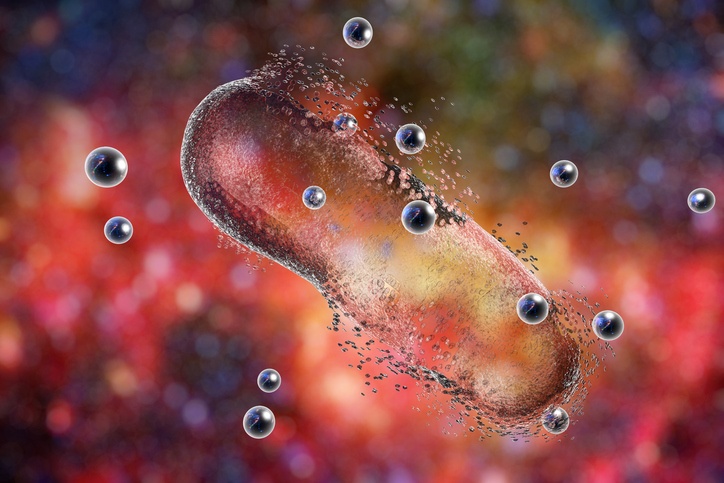
Superbugs, or bacteria that are resistant to currently available antibiotic treatments, are of growing concern to human health worldwide. Many of these superbugs are present in hospitals, and are frequently colonizing surgical sites and causing life-threatening infections and sepsis. The presence of these bacteria in blood is commonly detected by traditional culture methods that require one to two days. There is a need for a faster method to identify the presence of the bacteria and to take measures to prevent the spread of infection as rapidly as possible. One proposed technology is to use immunomagnetic separation with conjugated fluorescent probes to selectively bind bacteria and quickly visualize their presence in whole blood samples. Recently, fluorescent magnetic multifunctional carbon dots have been coupled with superbug-specific antibodies for the identification of the drug-resistant superbugs Staphylococcus aureus (MRSA) and Salmonella enterica serotype typhimurium definitive phage type 104 (DT 104) present in whole blood samples.
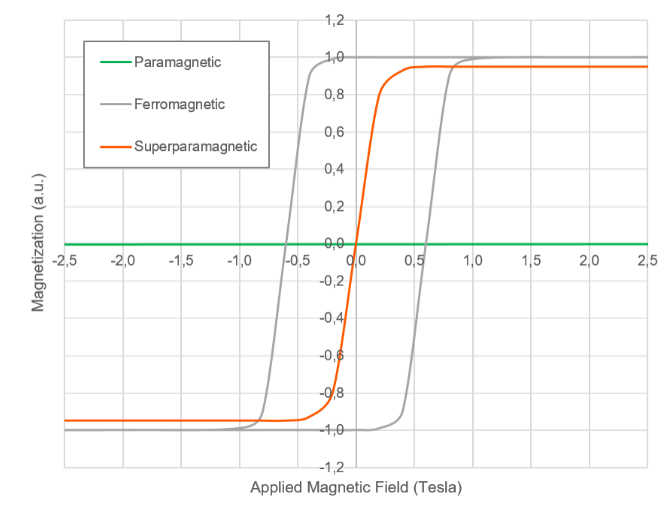
Magnetic DNA or RNA purification relies on the superparamagnetic property of micro- or nano-scale particles. These particles are most often made of iron oxide, with magnetite (Fe3O4) more commonly used than maghemite (Fe2O3). Superparamagnetic particles are not innately magnetic, but they become magnetized when influenced by a magnetic field. So, if the magnetic field is zero, then the particles are not magnetic at all, but when a magnetic field is applied the particles become magnetized.
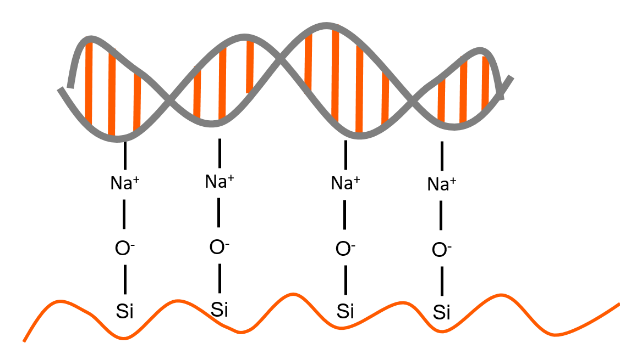
The traditional solid-phase support system is a static column. These columns are made of silica matrices or anion-exchange resins. They are porous and allow the solution to flow through them. These non-magnetic solid-phase columns require centrifugation to force the solution through. More recently, magnetic particles are being used as mobile solid-phase support systems for capture and purification of DNA and RNA. These magnetic particles are added to solution and are free to move around during the DNA or RNA adsorption period. They are then retrieved by magnetic separation. No centrifugation is needed for magnetic-particle nucleic acid purification.
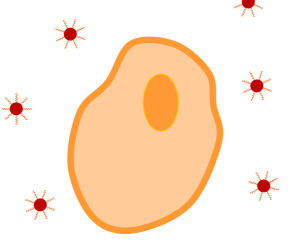
Nucleic acid separation can be fickle. DNA is fragile, and RNA even more so. Many commercial kits are designed to streamline the process, but they may not result in high yield or high purity DNA or RNA every time. Every laboratory is different; working habits vary, and experimental goals are not identical. It is tempting to rely on a single kit for routine isolation of genetic material because it is familiar, your lab may have published previous work with an established protocol, or you might not have the luxury or freedom to try something new. However, if you are experiencing consistently low RNA or DNA yield or purity then you may be able to justify taking time to gain a deeper understanding of the process, familiarizing yourself with the tools available, and possibly reworking your strategy.

Biomagnetic separation is a versatile and widely used tool in both industrial and small laboratory settings. It is used for the isolation of target drug molecules in the pharmaceutical realm, for the enrichment of enzymes in industry, and for in-vitro diagnostics in medicine. It is especially useful in the small-scale research environment for inexpensive target cell enrichment, protein isolation, or nucleic acid capture. In the early days of biomagnetic separation it was thought that the process was only reliable for small volumes. However, the development of modern biomagnetic separation racks has made it possible to scale up the process to large volumes and to enable process validation and consistency between batches.
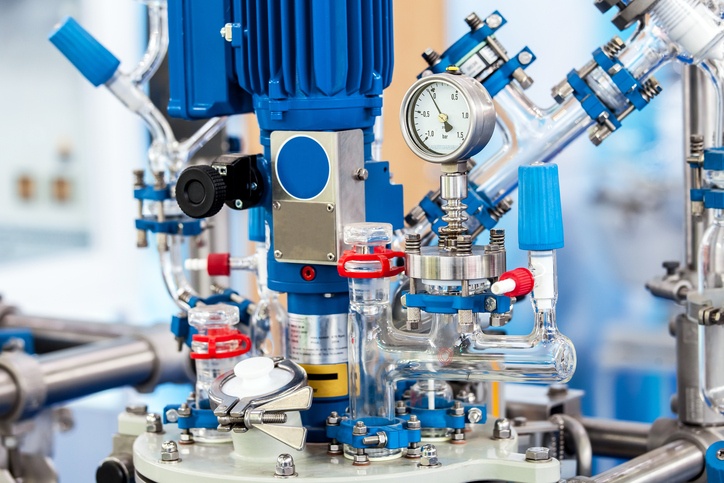
The ability to obtain an enriched population of small molecules, cells, proteins, nucleic acids, or contaminant-free solutions is important for all applications: from small laboratory research up to the large-scale production of pharmaceutical products. Filtration systems are available in all shapes, sizes, and materials for diverse situations. The need to meet regulatory guidelines for purity and consistency of pharmaceutical productsdemands a well-designed enrichment plan and filtration system.

Janus particles named after Roman god Janus who was illustrated with two faces, one looking to the future, and the other to the past. Pierre-Gilles de Gennes mentioned the term Janus particle in his Nobel lecture on soft matter in 1991. Janus particles are synthesized by joining two or more different materials together. Each material imparts a unique and useful quality to the particle; therefore, one Janus particle can display multiple properties and functionalities. It is this fundamental asymmetry that makes Janus particles a powerful tool in biotechnology for biosensing, bioseparation, self-assembly, drug delivery, and much more. This blog post will summarize a lengthy and informative reviewarticle of the same title that was published in Chemical Reviews in 2013.

Janus Particles and anisotropy
Janus particles (JPs) have two or more properties or functions wrapped up into one package. There are many different synthesis methods, properties, and applications for JPs. Anisotropy is defined as an object having a different physical property or different value when measured in different directions. Janus particles are anisotropic. Their properties are asymmetric. They can have a hydrophobic face and a hydrophilic face. They can have magnetic properties as well as optical reporters on the same particle. JPs can have different optical properties on either side. They can have different ligands on opposing faces. It is anisotropy that makes them useful tools for biosensing and bioseparation. One particle with multiple functionalities is often more useful than an isotropic particle with one property.
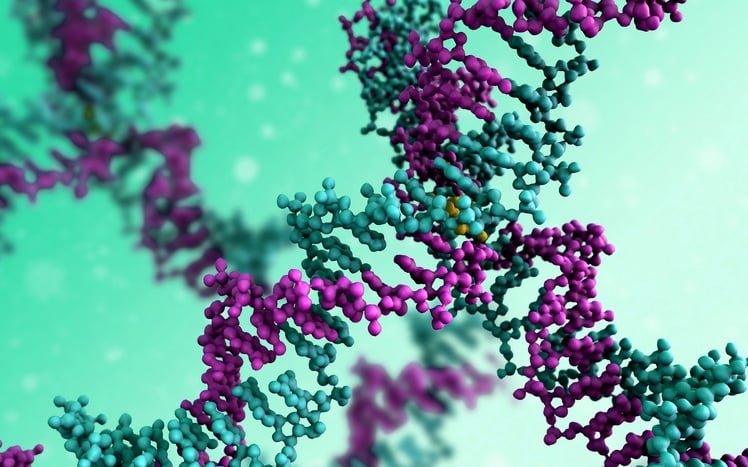
Antibodies labeled with fluorescent tags, radioactive molecules, biotin, enzymes, and other small molecules are essential for immunoassays, cell sorting, diagnostic assays, cell imaging, and other procedures. The attachment of small molecules to individual antibodies is not trivial, and to do it with a specific orientation is especially challenging. The purified antibody to be labeled must be in solution at high concentrations, and the process requires multiple washing steps. On-bead labeling methods are used to improve the labeling efficiency. Protein A binds to the Fc region of IgG antibodies across a variety of species, and is commonly used to capture antibodies onto a bead surface for isolation or for small molecule modification.
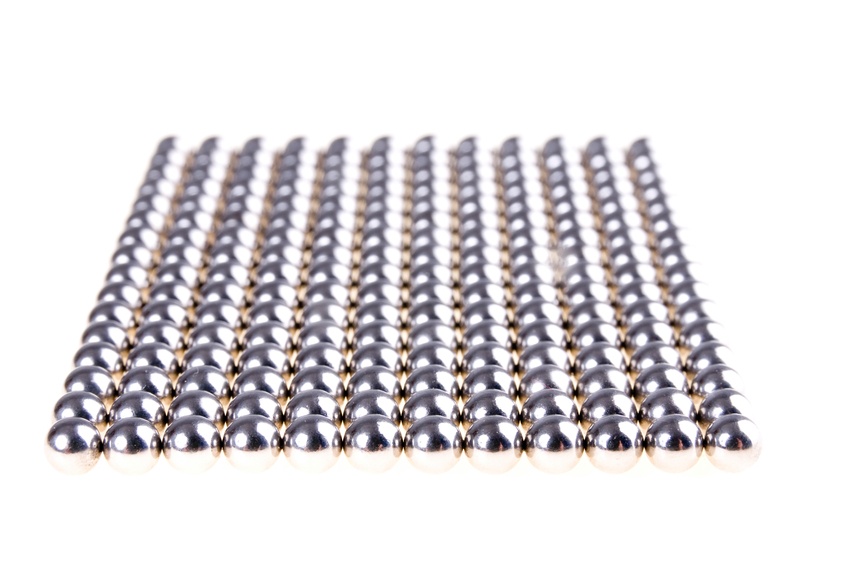
Streptavidin magnetic beads are used to isolate biotinylated biomolecules
The affinity between streptavidin and biotin is one of the strongest non-covalent interactions known in nature. It is extremely specific and is unperturbed by extreme changes in temperature, pH, and detergent. It is therefore a very useful tool in biotechnology. For example, the system is commonly used in magnetic separation. Target molecules are biotinylated, which means that a biotin molecule is covalently attached to the protein, nucleic acid, or other molecule of interest. Streptavidin-bound magnetic particles are incubated with a solution containing the biotinylated target molecule for a sufficient time for the streptavidin-biotin affinity to form. The complexes can then be isolated from solution by magnetic separation.
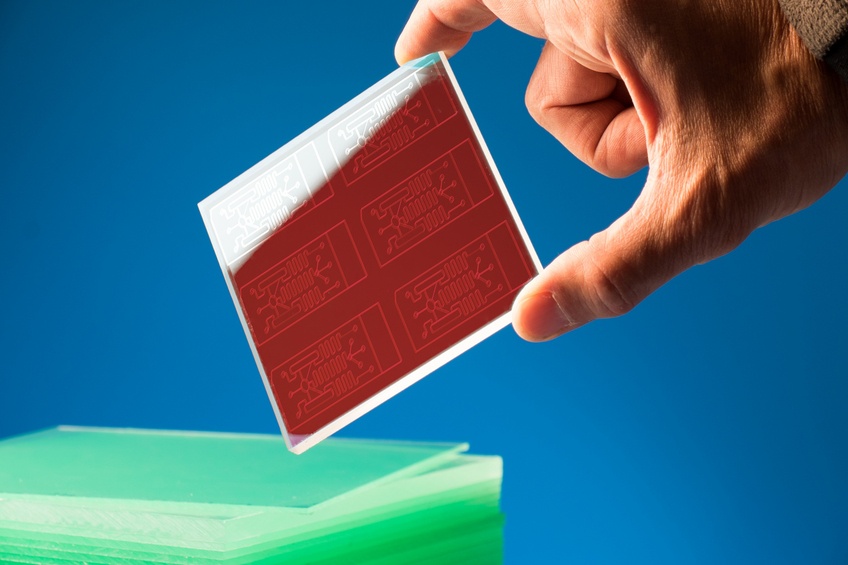
The Zika virus (ZIKV) is emerging as a global public heath threat. It has been linked to the development of microcephaly in newborn babies whose mothers’ were infected by ZIKV during pregnancy. Recently, it has been shown that the virus can be sexually transmitted. The clinical signs in adults include fever, rash, joint pain, and conjunctivitis, which are common clinical signs for a general viral infection. This makes clinical diagnosis difficult without a specific immunoassay. The current methods for ZIKV detection are qPCR (quantitative polymerase chain reactions) or ELISA (enzyme-linked immunosorbent assay). Each of these is time consuming and the reagents can be expensive. As more people become infected and the virus spreads throughout the population it will become necessary to find a cheaper and faster alternative assay for detection of ZIKV. A magneto-actuated chemiluminescence immunoassay for the Zika virus has been developed. The demonstrated limit of detection is comparable to qPCR.
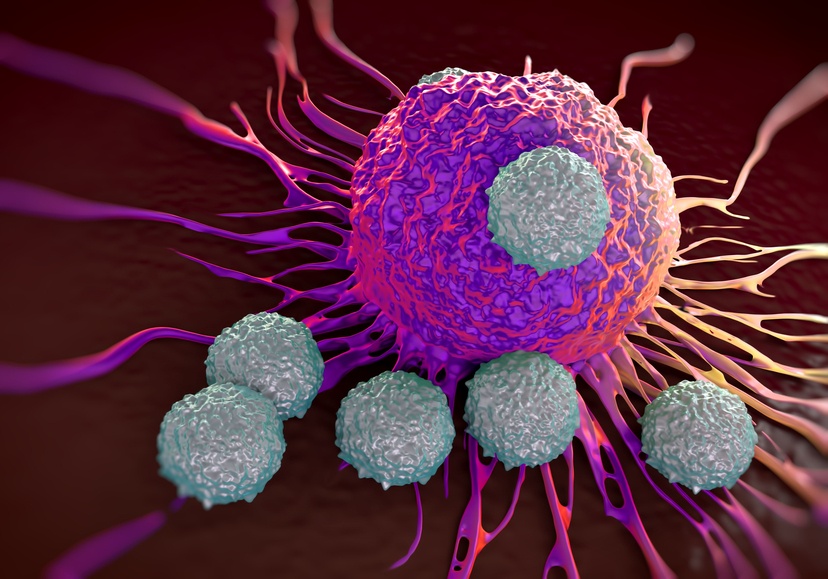
CD4+ lymphocytes are of particular interest in patients infected with Human Immunodeficiency Virus (HIV). A devastating effect of this retroviral infection is a progressive loss of CD4+ cells. These cells are crucial to a healthy immune system. When the level of CD4+ cells fall below 200cells/uL whole blood the patient is diagnosed with Aquired Immune Deficiency Syndrome (AIDS).
Therefore, the number of CD4+ cells in these patients is a good way to determine when to start antiretroviral treatment, and to administer drugs to protect against opportunistic pathogens. Currently, the most accepted way to measure the CD4+ concentration in whole blood is to use flow cytometry. However, this technology is extremely expensive and requires trained technicians to operate and maintain the machine. An alternative method is needed in resource poor areas. This alternative method would ideally be implemented at the point of care to avoid transportation of samples to and from a laboratory. One such recently developed technology is a magneto-ELISA to detect the concentration of CD4+ lymphocytes in whole blood. The detection system relies on magnetic separation to obtain an isolated population of CD4+ cells. It has a demonstrated limit of detection of 50 Cd4+ cells per μL, which is sensitive enough to diagnosis AIDS.
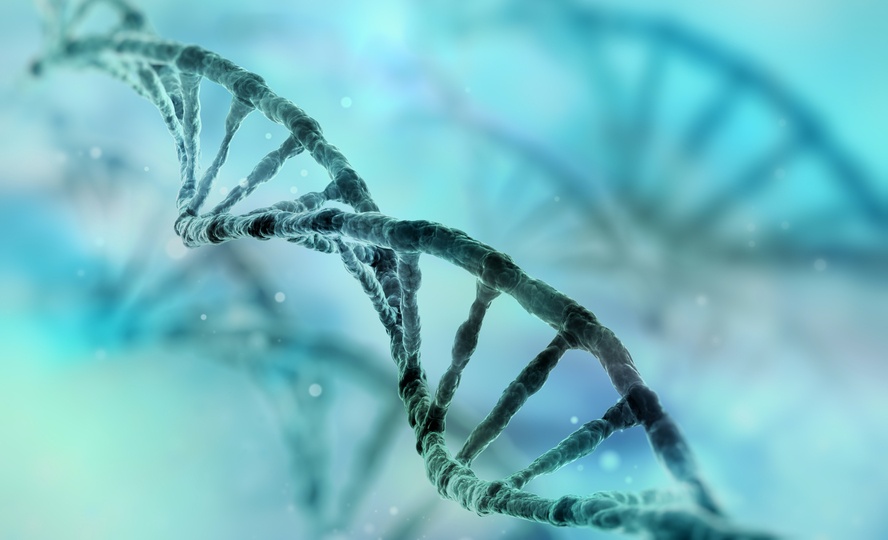
Efficient methods for DNA detectionin clinical, environmental, and experimental samples are constantly in demand. In a clinical sample, DNA capture and identification can be essential to the diagnosis of disease. In public heath and environmental situations it can be used to identify contamination of food or water. DNA collection and characterization is constantly expanding our ability to answer experimental questions. DNA capture is a mainstay of modern biotechnology. Traditional techniques rely on affinity columns, centrifugation, and multiple washing steps. Newer methods are based on magnetic separation. In the beginning, magnetic separation was limitedto packing a column with magnetic material and running a solution through it. As nanotechnology evolved it became possible to use mobile solid support systems such as magnetic nanoparticles.
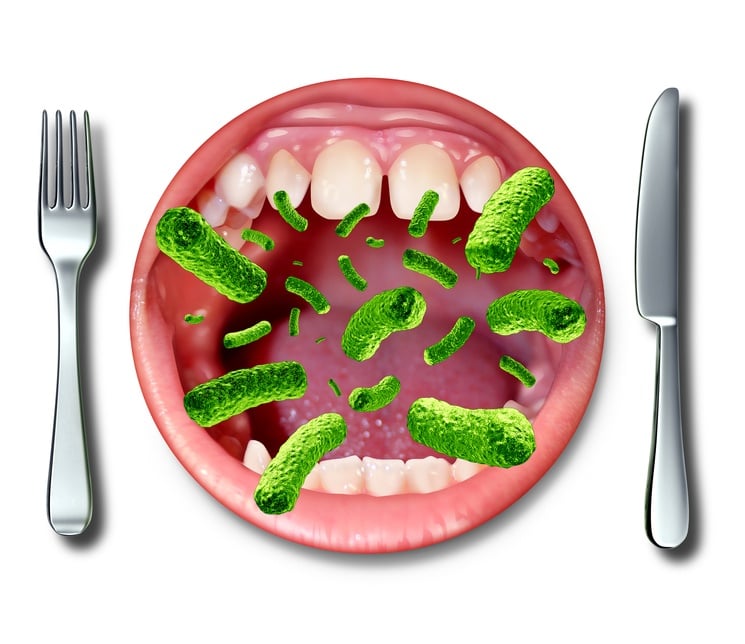
When food becomes contaminated with pathogens it is necessary to identify the contamination and remove that food from the supply line as soon as possible. When that food is perishable it becomes all the more important to act quickly, but this demands a rapid detection system. This “need for speed” automatically eliminates the traditional culture method from the list of potential detection techniques. A commonly used method for pathogen detection is to isolate the pathogen and concentrate it enough to be accurately amplified and detected by real time quantitative polymerase chain reaction (RTqPCR). However, the method used to capture and concentrate the pathogen needs to be rapid and efficient. Magnetic nanoparticles and magnetic bead separation techniques are the perfect technologies for the rapid isolation and concentration of pathogens.
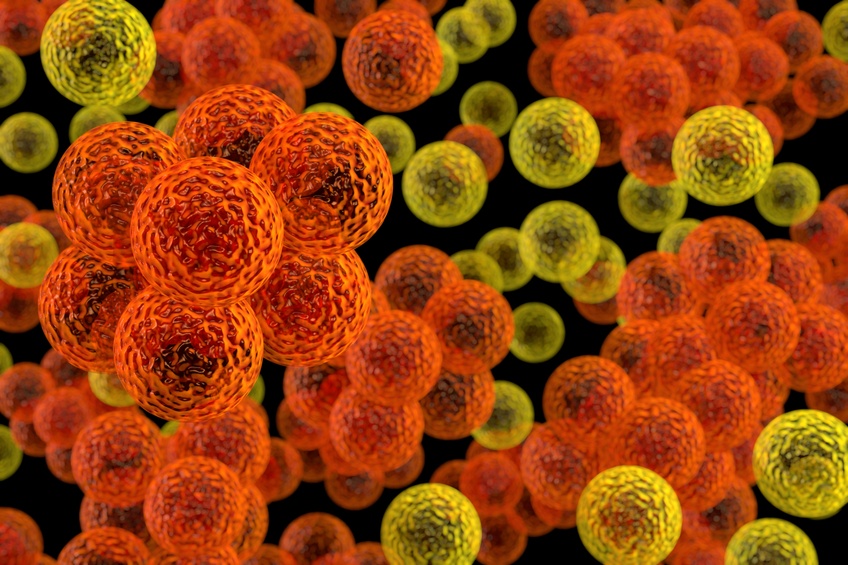
The bacteria Staphylococcus aureusis of major concern in modern healthcare.Once it spreads to a patient’s bloodstreamthe infection can lead to sepsis and death. Hospitalized patients are particularly vulnerable, especially those with weakened immune systems. Some strains of S. aureushavebegun to demonstrate antibiotic resistance. For these reasons it is important to identify and contain infection early; rapid detection of bacteria in patient sera is key. Traditional culture methods are time-consuming and require transportation of samples to offsite clinical laboratories.Development of a rapid point-of-care diagnostic tool is desirable, andthe magnetic nanoparticleis rapidly becoming the tool of choice.
First use biomagnetic separation to isolate the target molecule
Magnetic nanoparticles are fantastically customizable due to surface coatings and functional moieties, and are easily recoverable from solution. A functionalized nanoparticle will bind to its target after a short incubation time, and the conjugate can be isolated with the help of a magnetic separation rack. This technology allows for the rapid selection and concentration of a target molecule. Once the target molecules, in this case S. aureus bacteria, are isolated, further identification methods can be used. This is where a group of researchers working in Istanbul, Turkey became creative.
The grouphas engineered a S. aureus detection system using a mesoporous silica nanoparticle-oligonucleotide conjugate. The system’s limit of detection is 682 cells/mL, which indicates potential for use as a point-of-care diagnostic. The system detects Micrococcal nuclease (MNase), which is an enzyme specifically secreted by S.aureus. MNase degrades RNA or DNA, and is well known within the field to be a marker of S. aureus infection.
The system works as follows:
- A sample of blood (1 mL) is mixed with magnetic nanoparticles coated with silica and functionalized to bind to S. aureus.
- The nanoparticle-bacteria conjugate is isolated from solution by biomagnetic separation.
- The isolate is heated to release MNase out of the bacteria and into solution
- A non-magnetic mesoporous silica nanoparticle filled with fluorophore is added to the solution. The pores of this nanoparticle are sealed shut with oligonucleotides that are resistant to degradation by all nucleases except MNase. When the pores are capped the fluorophore is quenched and no fluorescence is visible.
- If MNase is present in solution the oligonucleotide caps are degraded, the nanoparticle pores open, and the flurofores are released. The free fluorphores are no longer quenched, and a fluorescence signal is measured.
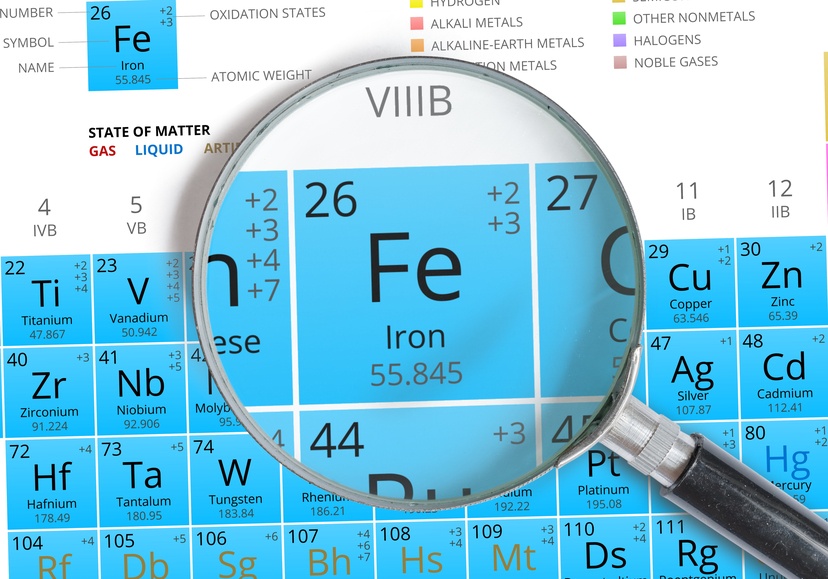
The use of magnetic nanoparticles and biomagnetic separation to isolate proteins from solution is advancingover more traditional column-based methods. Magnetic nanoparticles provide a gentler and more rapid separation process compared to column-based methods, and often demonstrategreater yield. With a properly scaled separation rack the separation process can be monitored in real-time and calibrated across experiments.

There are many variables to consider when designing a magnetic separation system and tailoring it to the experimental goal. Bead surface functionalization is one key component, and often receives the most attention because it is the most obvious point of control for assay specificity. However, it is easy to lose site of the fundamental mechanics of magnetic separation. When designing a magnetic separation protocol it is also important to consider the movement of the magnetic particles in the magnetic field gradient. Superparamagnetic particles will form chains when placed into a magnetic field, a key property to have high enough separation speed for practical purposes.
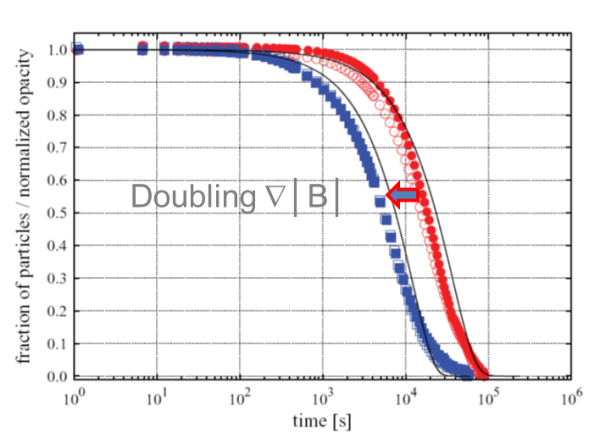
Biomagnetic separation is a technique that uses small superparamagnetic iron-oxide particles and a magnet to separate cells or nucleotides from solution. These particles are often called magnetic nanoparticles or microspheres due to their small sizes ranging from less than 100 nm to 5 μm. The magnetic particles are chemically altered (functionalized) to be biologically compatible and to specifically bind to a variety of different cell types. The targets of interest can be bound by the particles and isolated from solution (positive selection) or the unwanted targets can be bound and removed from solution (negative selection). Magnetic bead cell sorting has many advantages over traditional column-based methods due to increased specificity, decreased procedure time, and increased cell viability.
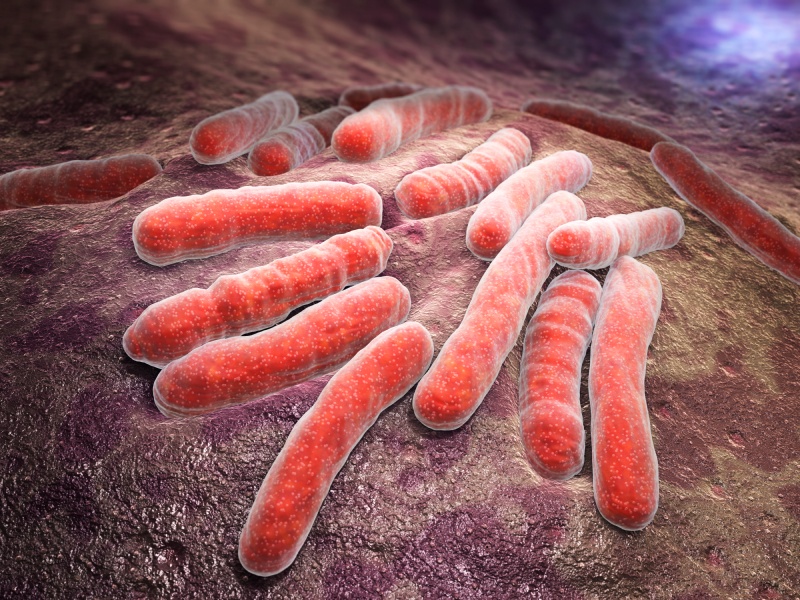
Immunomagentic separation is a selective and faster assay than microbiological culturefor detection of bacteria in food, water, or clinical samples, but it still has limitations. A novel bacteriophage-based magnetic separation has been developed to take the magnetic separation assay to the next level.

The study of protein complexes is often difficult due to their physical properties. Proteins are many times hard to isolate with traditional chromatographic methods, especially large molecules in complexes.This is due to most complexes being maintained by non-covalent bonds, which are easily disrupted during isolation.
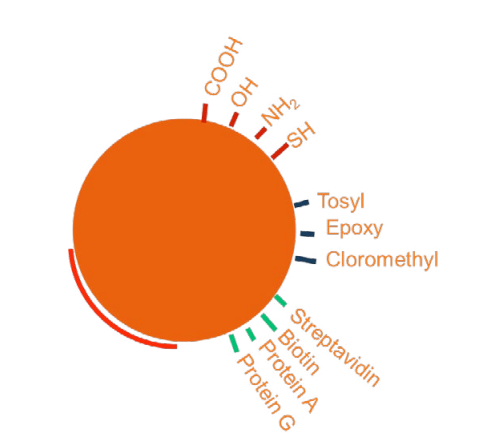
Magnetic bead technology has developed rapidly in the past decade. New functionalization strategies are continually hitting the market as more laboratories begin to use magnetic separation systems to identify and isolate cells and microorganisms. There is a direct correlation between advanced functionalization strategies and improved assay selectivity. The size of magnetic beads (μm-nm) places them squarely into the cellular realm, and their surface functionalization causes them to bind to specific surface ligands. This functionalization step is crucial to the separation process because it allows the operator to control which cells the beads will bind to. For a positive-selection immunoassay, the bead surfaces are functionalized by covalent attachment of an antibody that will bind to the cell or micro-organism of interest. This bond ensures that the microbe-bead conjugate will be captured in a magnetic field gradient.
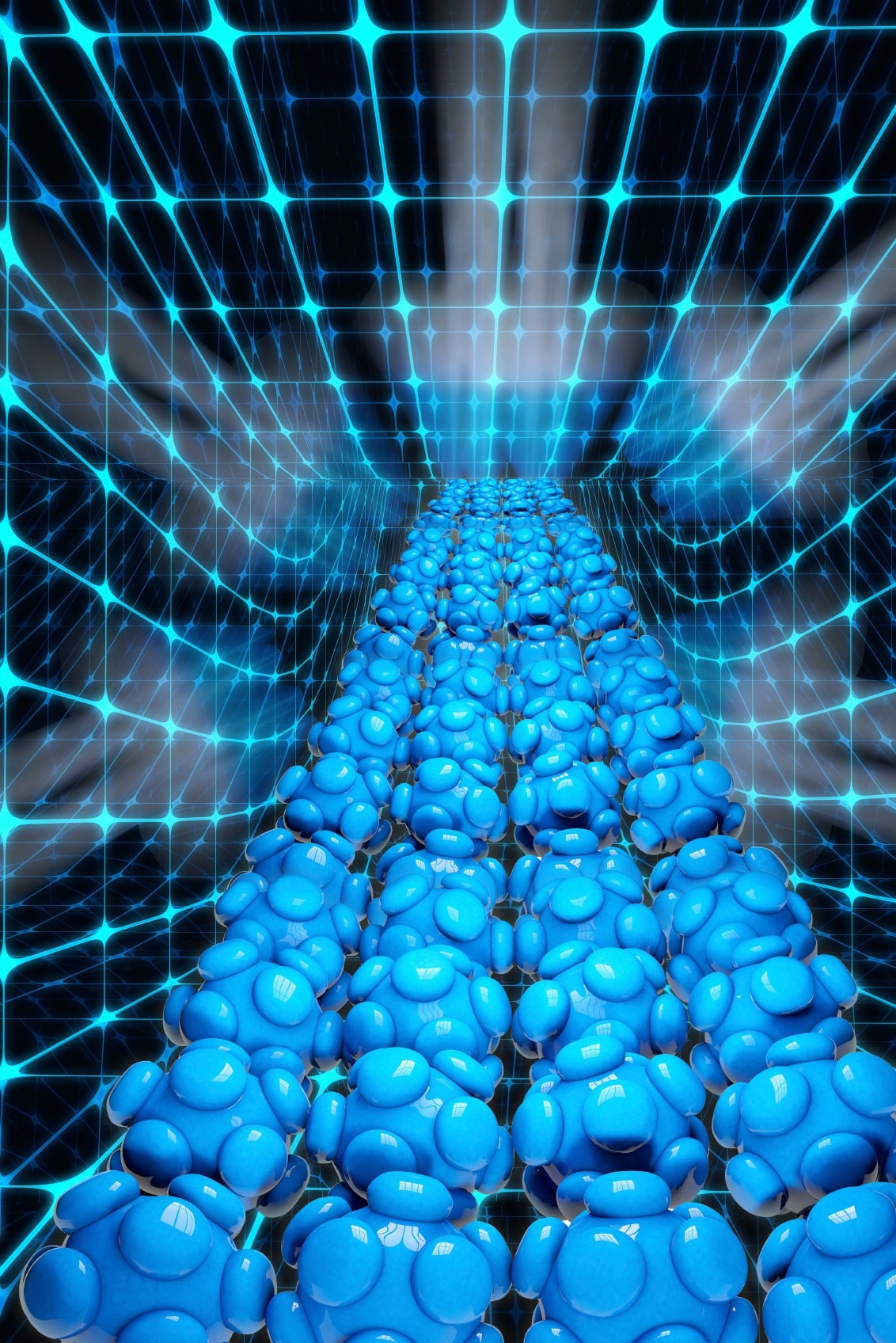
Within Nanoparticles (NP), Magnetic nanoparticles (MNPs) can be influenced using an applied magnetic field. Due to restricted size effects such as high surface-to-volume ratio, these MNPs demonstrate high magnetic properties compared to their corresponding large particles. The component of magnetic nanoparticles ranges from 5.0 nm to 50 nm in size and display a unique feature known as ‘super magnetism’ in the presence of an externally applied magnetic field.
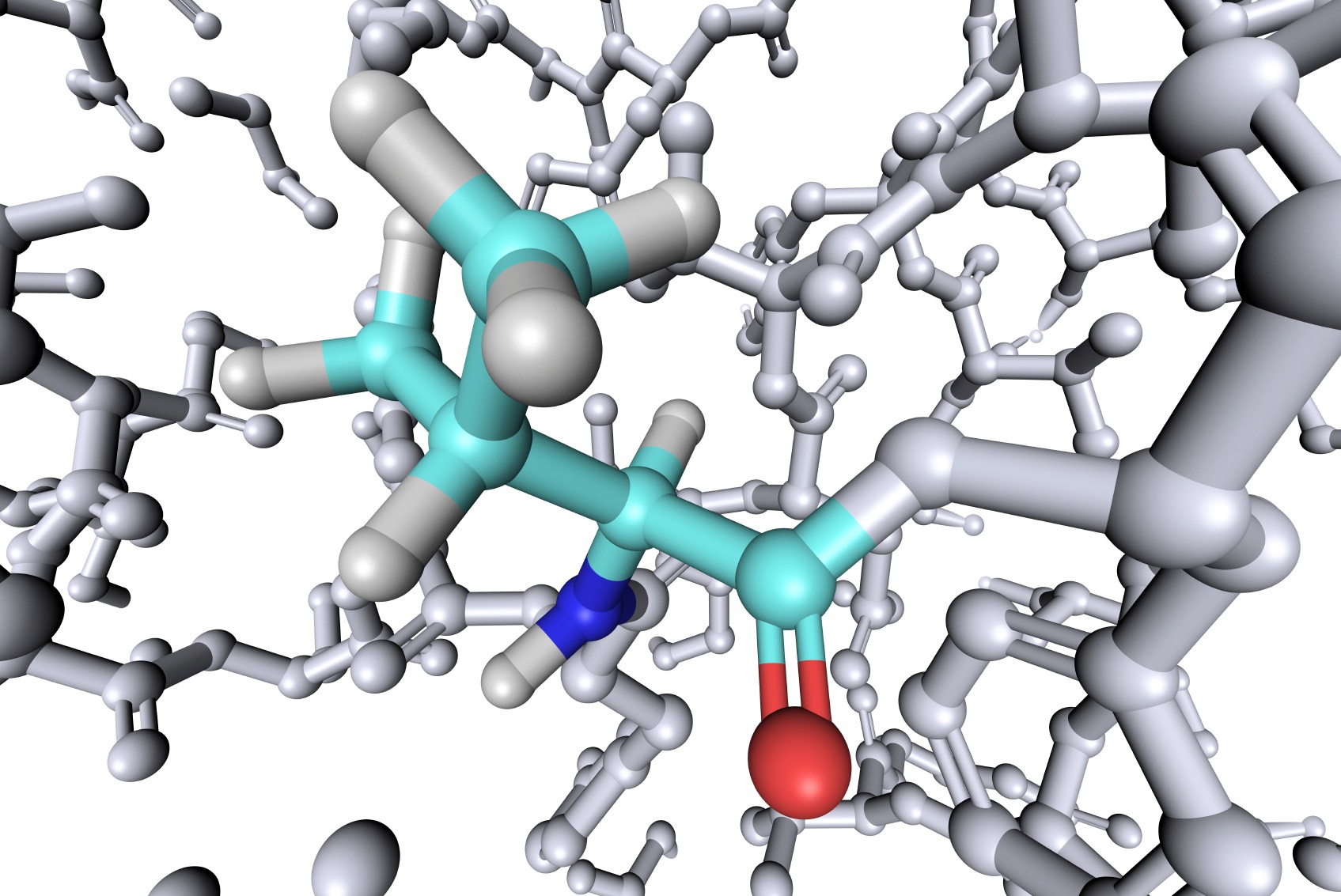
Magnetic beads or Magnetic labels are the most suitable nanometric-sized iron oxide particles for extracting biological molecules prior to their detection. These are either encapsulated or attached together with polymers with the size ranging from 35nm to 4.5μm. First discovered by French scientist Louis Neel, a winner of Nobel Physics Prize in 1970; these magnetic labels exhibit several features, well tailored for various applications.
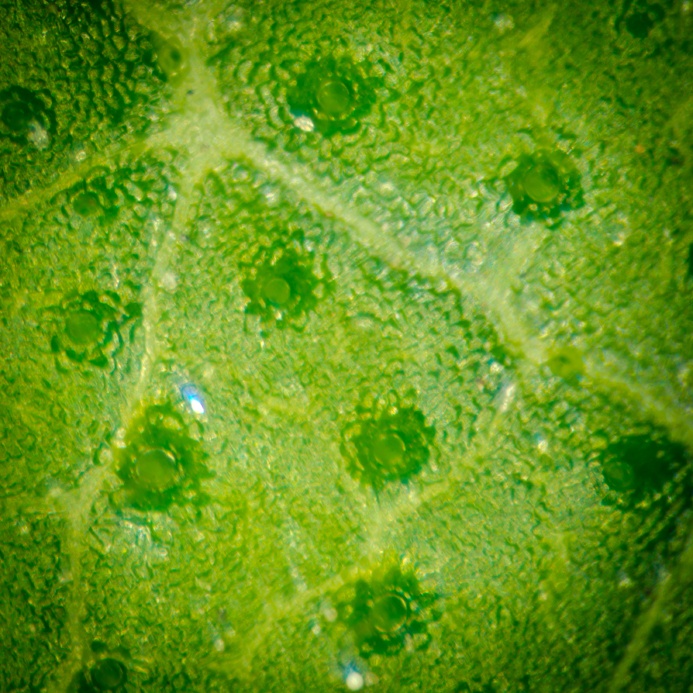
Vacuolar processing enzyme (VPE) is involved in manyplant physiological processes and functions as a cysteine protease. It plays important roles in immunity, programmed cell death, leaf senescence andseed maturation. VPE has caspase-1-like activity and it is thought that caspases are evolutionarily related to this enzyme. The biological relevance of VPE makes the development of tolls to study this enzyme extremely valuable for research purposes.
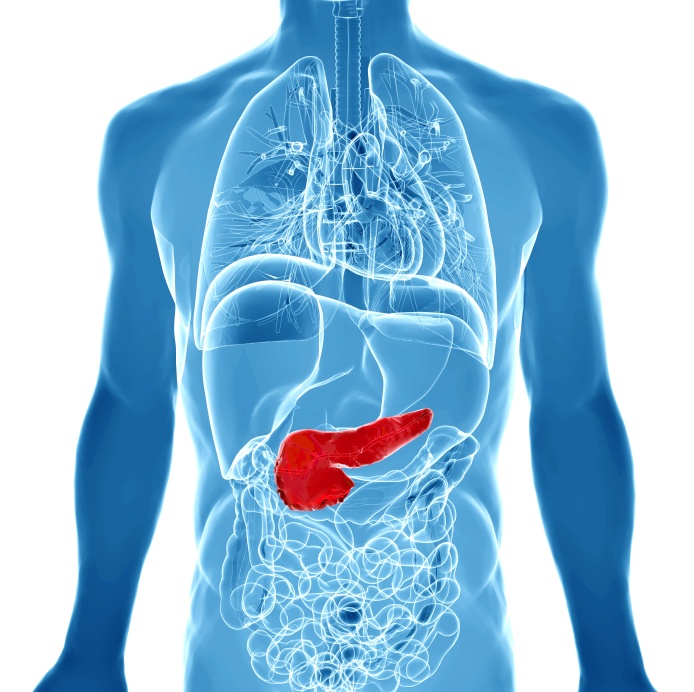
Pancreatic cancer is one of the most deadly forms of cancer with a survival rate of only 6%. Most cancer therapies are not effective in the treatment of pancreatic cancer because cancer cells are intrinsically resistant. The study of molecular and cellularcharacteristics of the tumor is therefore essential to understand how this cancer works at the molecular level and to develop new therapies. We now have all the techniques available to do a full characterization of cancer cells, such as DNA and mRNA sequencing, and signaling protein arrays. This molecular characterization allows a better classification of the tumor and therefore helps to predict response to treatment and prognosis.
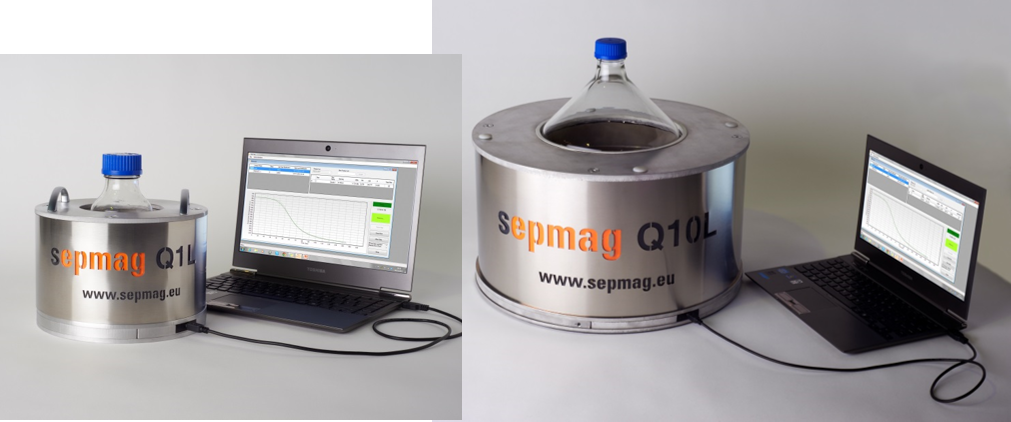
The scaling up of a biomagnetic separation process is not an easy task if we use classical magnetic separators. In these devices, the magnetic force over the beads changes with the distance, thus the magnetic force profile is very different at different volumes. However, using advanced biomagnetic separation systems, the magnetic force becomes constant at all the working volume. Then the process scaling up is straightforward: you just need to use systems with the same magnetic force, and you would have the same separation conditions regardless the scale.
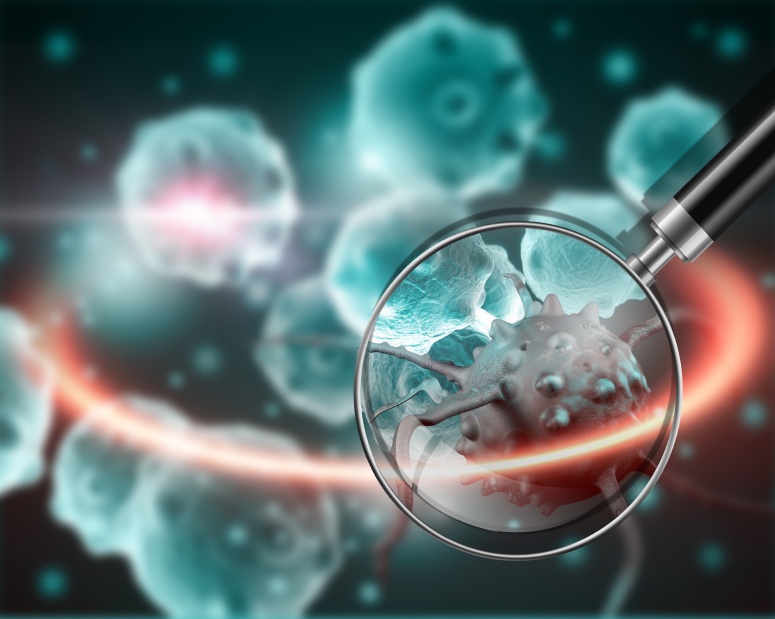
Mycobacterium avium subsp. paratuberculosis (MAP) is the causative agent for Johne’s disease that affects cattle and leads to wasting of the infected animals. In a herd, most animals infected are asymptomatic but still propagate diseasethrough their milk and feces. This makes the most susceptible animals develop sickness and the within-herd transmission uncontrolled. It is therefore important to detect MAP infection early and even when it is causing only latent infection. The most used test for the detection of MAP in animal blood or milk samples is ELISA with MAP-specific antibodies. The problem with this essay is that the detection limit is high and this leads to false negatives, which limits the effective detection of infected animals. The most sensitive method available is liquid and solid culture. However, since MAP has a slow growth rate and no media is truly selective for these bacteria, there are a lot of instances where culture overgrowth by contaminating organisms impairs MAP viability and limits detection to 23% with many false negative results. Molecular based methods such as PCR are also used and are more rapid and sensitive but they do not assess the viability of MAP cells.

Stablishing a separation time is the most usual way to specify a biomagnetic separation process. The problem is that this magnitude is not only related with the magnetic beads suspension, but also with the specific system used to perform the separation.

Nucleic acid detection is crucial in the clinical practice since it can be used to rapidly identify pathogenic organisms. Rapid detection with highly sensitive methods is essential for diagnosis and choosing treatment courses. This is a complex task since samples need to be enriched with the nucleotide targets and at the same time needs to eliminate nucleases, PCR inhibitors and host material. This means that to detect and identify genetic material from a pathogen, in the form of 18S and 28S rRNA, in an efficient and reliable way, the protocol needs to eliminateeukaryotic rRNA from the sample to avoid competition for the substrates during the cDNA synthesis, since it decreases the detection sensitivity.
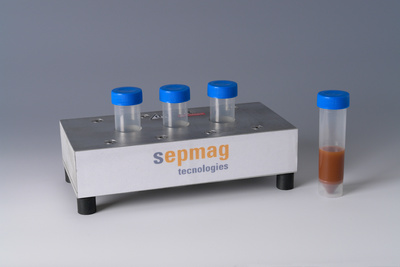
The Sepmag equipment is mentioned in the Encyclopedia of Inorganic and Bioinorganic Chemistry on the chapter “Biomedical applications of magnetic nanoparticles” written by Daniel Ortega. This chapter starts with examples of several magnetic isolation methods such as the isolation of macromolecules from enzyme separation that involves immobilized affinity ligands to the removal of cancer cells frombone marrow, which is one of the most important applications ofbioseparation techniques.

Magnetic separation techniques have become an essential tool in many areas of research. Most technological advances in these techniques have been possible due to the work of many researchers trying to solve everyday technical problems or optimizing existing protocols. In order to get the specialists in the field from all over the world together, meetings are an important way for contact between researchers that can help find new applications and solutions in the scientific and clinical setting.

Magnetic separation techniques are becoming more and more versatile as researchers take advantage of this technology to tackle everyday problems and come up with innovative solutions. One striking example of this innovation capacity is the technique developed recently by Ziyuan Wang and colleagues. These researchers combined magnetic separation beads with bacteriophages to selectively isolate bacteria. Since they wanted to purify Escherichia coli from samples with high affinity and specificity they used T7 bacteriophages to act as binding molecules, similarly to how normally antibodies are used.

Clinical validation of Raman scattering with magnetic beads in the diagnosis of rheumatoid arthritis
Surface-enhanced Raman scatteringis a new technique to perform immunoassays that can be used to detect several disease biomarkers.It is better than traditional immunoassays, like ELISA, since it is more sensitive, selective and takes less time, which are precious things in diagnosis.

Uranium is an environmental pollutant with severe health and ecological consequences since it has radioactive and chemical toxicity affecting mammalian reproduction and development. Therefore, the environmental detection of this element is essential, to prevent deleterious effects on the ecosystems.
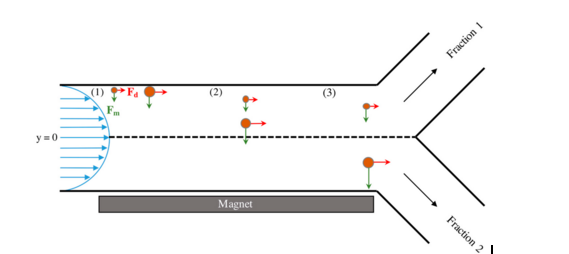
Magnetic nanoparticles are susceptible to a magnetic field. If the magnetic field is constant then the particles will experience torque and will spin in place
Τ = m x B
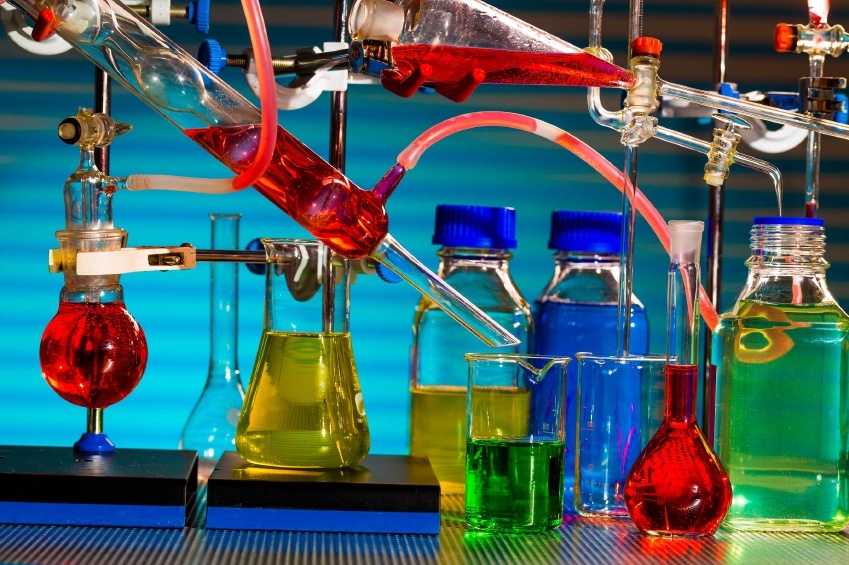
The size of magnetic nanoparticles is very important. The behavior of the magnetic particle in a magnetic field gradient is dependent upon the particle’s diameter. The ability of the particle to overcome drag force and move in the direction of a magnetic field gradient is dependent on the size of the particle.
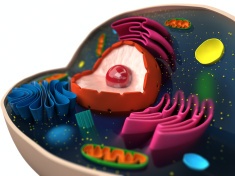
Extracellular vesicles are structures released by cells and include exosomes,microvesicles, and apoptotic bodies. These vesicles are an important diagnostic toll since they carry substances from their cells of origin into circulation. The biomolecules contained within, such as RNA and proteins, can be used to determine if the cells that produced them are being affected by a disease. For example, cardiovascular diseases and cancer, lead to increase in specific extracellular vesicles. Isolating these vesicles form body fluids is not a simple task.
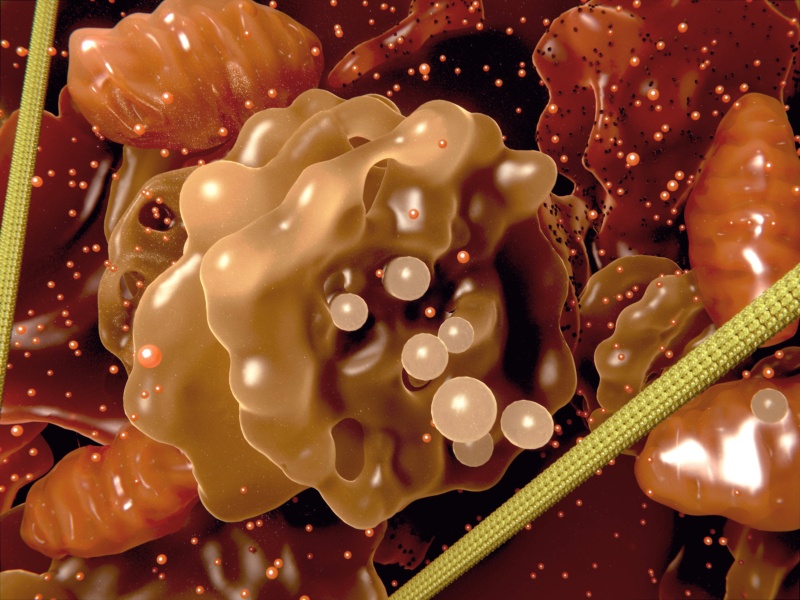
The study of biological processes is getting more complex and has to take more factors into account. Physical forces are an important part of normal physiological processes and their impact has been largely overlooked in the in vitro study of biological mechanisms. The cellular force sensing mechanisms play important roles in disease. For example, in atherosclerosis endothelial cells have to respond to pulsatile forces and stiffening of the arteries.
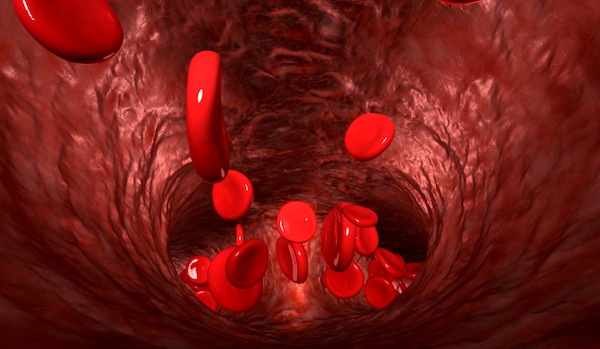
Repair of blood vessels is essential to maintain homeostasis and this process is driven endothelial colony-forming cells. These are vascular lineage-specific progenitor cells that have the ability of driving post-natal vasculogenesis. Endothelial progenitor cells are mobilized into circulation by mediators released due to vascular trauma. Initially, it was though that these cells only acted during embryonic development, but now we know that they are equally important to restore the tissues’ vascularization after disease, especially in heart disease and cancer. Therefore, these cells have therapeutical potential in the treatment of conditions affecting the vascular network. The problem is that these are very rare cells in circulation accounting for only 0.01% of all cells.
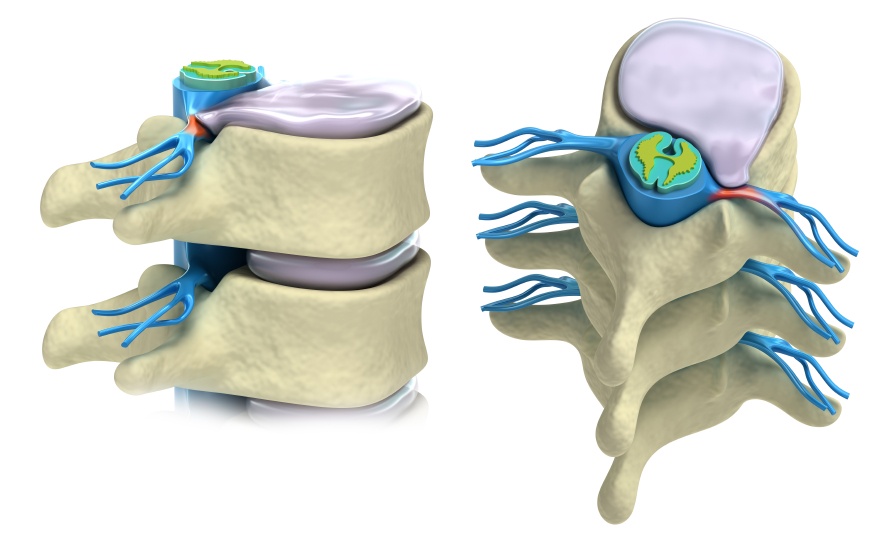
Connective tissue progenitors (CTPs) are used as a therapy for bone repair. These cells can be isolated thanks to their expression of hyaluronan, a membrane glycosaminoglycan. Since these cells are rare relatively to other cells in the bone marrow (1 for 20000) it is difficult to obtain enough cells for therapeutical application. The problem with the application in humans is that CTPs need to be isolated from bone marrow suspensions to obtain a high number of viable cells. This procedure implies collecting bone marrow, separating the CTPs and engrafting them in the patient which, due to the complicated nature of rare cell isolations, would need two surgical procedures. Therefore the process of separation needs to be quick and efficient without impairing cell function.
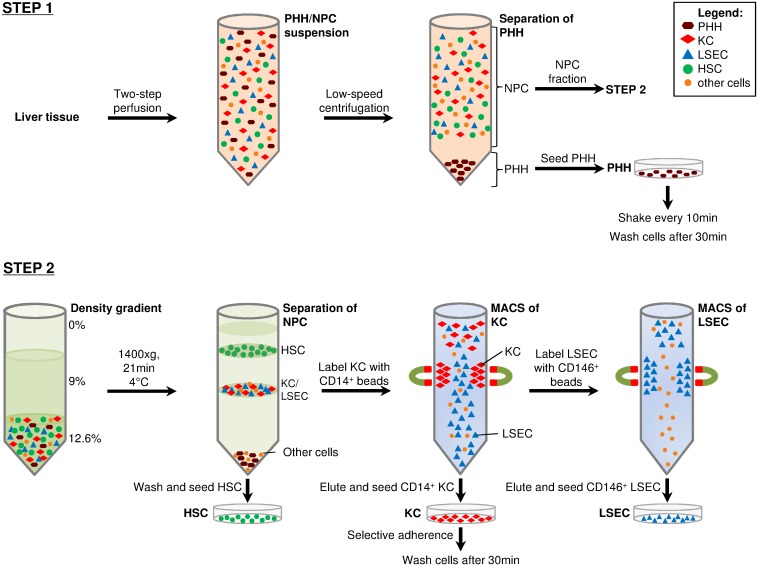
Isolating and culturing primary human hepatocytes is an essential tool to measure liver function, study metabolism and perform hepatotoxicity drug tests. When investigating liver diseases comparative studies of diferent cells within the same patient sample are essential. This approach has many drawbacks since the liver is composed of 80% parenchymal cells (hepatocytes) and 20% non-parenchymal cells, making it difficult to obtain cellular fractions representative of all the subsets present in this organ. Additionally, the obtained cellular fractions usually lack the purity and viability necessary to analyse cell-specific features.
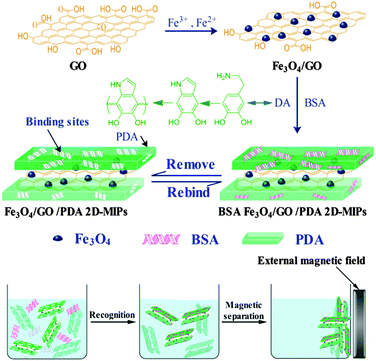
Removal of a protein from solution requires specific recognition of the protein. This has been accomplished through the use of antibodies, epitopes, and functional moieties for years. Now there is a new tool available. It is called a molecularly imprinted polymer (MIP). MIPs have cavities in the polymer matrix that are the perfect fit for the target protein. They have all the right functional groups in all the right places, and this is due to the way they are made.

At the end of the year 1959, Richard Feynman presented his talk entitled There's Plenty of Room at the Bottom to the brightest physicists of the time. The conference participants shared a general feeling that the greatest advances in science had already been made. In a sense, they felt that the good discoveries had already been taken and only scraps remained for them. Feynman challenged this attitude by suggesting that there were more discoveries waiting to be made than they could even imagine. To find them, they needed to look at the nanoscale.
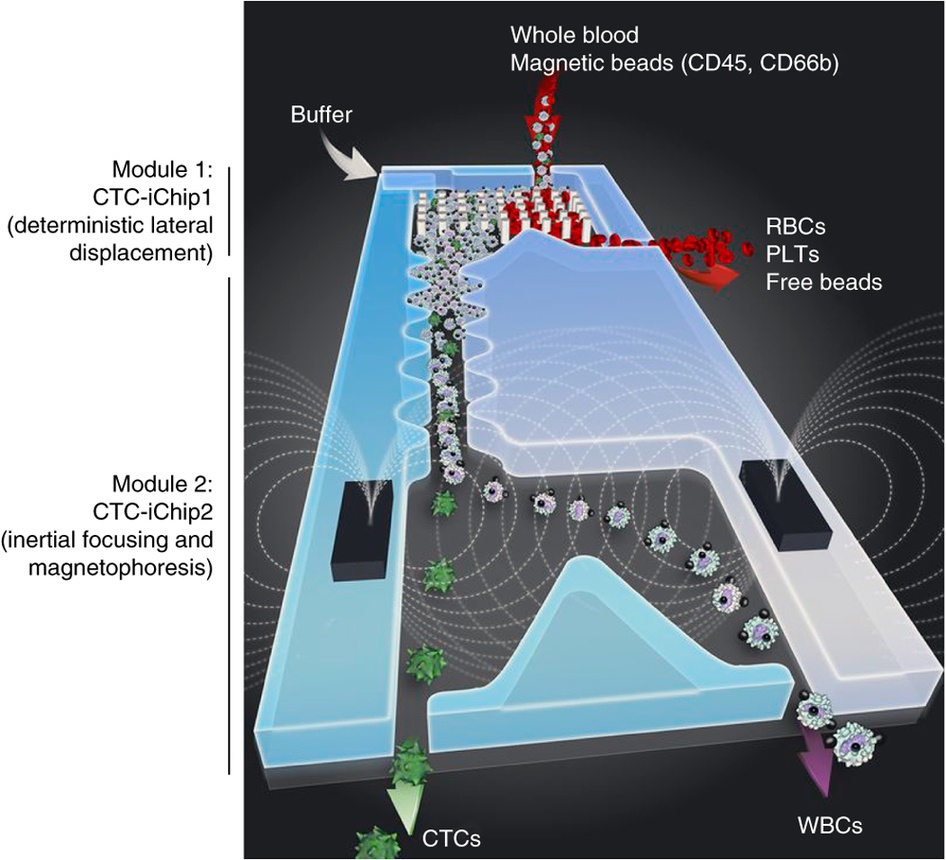
The isolation of circulating tumor cells is essential to diagnostics and metastasis studies. Since these cells are rare compared to the whole cell content of blood, the isolation process poses a challenge. There are several widespread methods of analysis and isolation of circulating tumour cells, from direct analysis of blood by marking tumor cells selectively, to blood processing through flow cytometry and magnetophoresis, that are based on EpCAM expression by tumor cells. However, circulating tumor cells from cancers of non-epithelial origin and cells that go through epithelial to mesenchymal transition do not have EpCAM. Therefore, these approaches have the tendency to lose rare cells.

Sepmag is yet again reaching new audiences by publishing the first of a two-article series about biomagnetic separation.
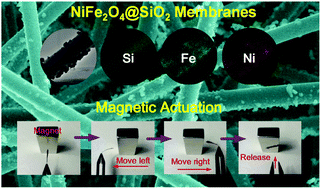
A team of scientist in Shanghai, China has placed magnetic nanoparticles into the thin-film realm. The group has created a flexible magnetic nanofibrous membrane by combining gelatin dip-coating methods with electrospun silica nanofibers. An external magnet can control the membrane flexion. The membrane also demonstrates selective wettability meaning that it is impervious to oil while easily allowing water to penetrate through.
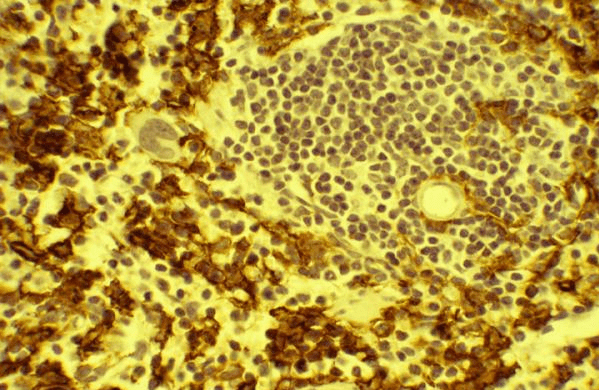
Magnetic activated cell sorting: Description of the technique
Magnetic activated cell sorting (MACS) is a technique whereby specific cell populations are isolated from solution through the use of superparamagnetic iron-oxide nanoparticles and an external magnet. Describing the nanoparticles as superparamagnetic indicates that they are not intrinsically magnetic, but can become magnetized when influenced by a magnetic field from an external magnet. The nanoparticles are coated with polymers or polysaccharides and functional moieties to make them biocompatible and capable of binding to one cell population of interest. After an incubation period, during which the nanoparticles bind to the cells, an external magnet is applied and the nanoparticles move through the magnetic field gradient to be isolated from the solution. The unwanted cells and contaminants are washed away to produce a pure cell isolate. That cell isolate is often cultured or molecularly analyzed. It is important to avoid contamination, but recent research on splenic cell isolates has discovered that splenic red pulp macrophages are intrinsically superparamagnetic, and are separated out of solution along with the nanoparticle-bound cells.
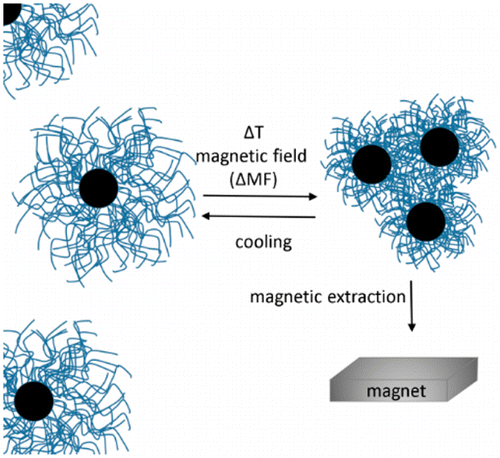
Many people are not aware that magnetic nanoparticles used in cell separation techniques must be able to aggregate when a magnetic field gradient is applied. If the particles fail to aggregate they remain as single entities and are difficult to separate out of thesolution. An aggregation of magnetic nanoparticles is highly influenced by a magnetic field gradient and can be easily isolated and removed. Therefore, a thermally controlled reversible aggregation system is desirable.

The latest trends and concepts in the In-Vitro Diagnostic (IVD) products market will be presented by leading representatives of Merck Millipore.
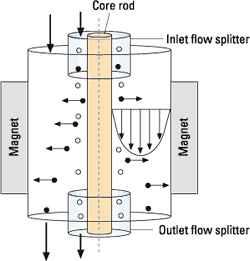
Magnetic Activated cell sorting is a technique that uses small paramagnetic iron-oxide particles to separate cells or nucleotides from solution. These particles are often called magnetic nanoparticles due to their small sizes ranging from less than 100 nm to 5 μm. The technique requires and external magnet to create a magnetic field gradient. The magnetic particles are chemically altered to be biologically compatible and to specifically bind to a variety of different cell types. The cells of interest can be bound by the particles and isolated from solution (positive selection) or the unwanted cells can be bound and removed from solution (negative selection).
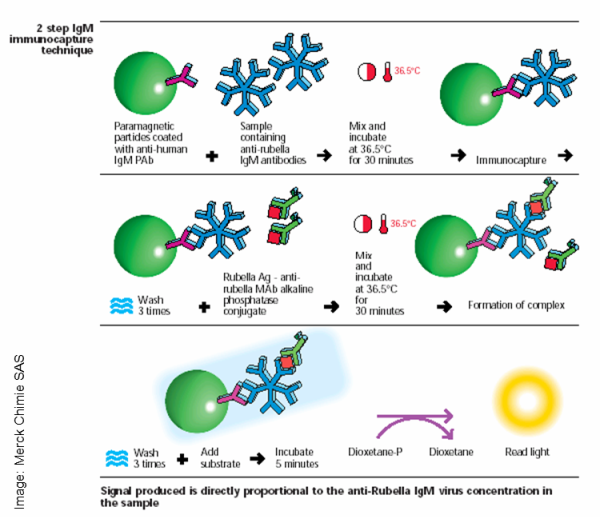
The chemiluminescent immunoassay is a technique used for disease diagnosis, drug development, chemical reaction monitoring, and many other applications. The protein or antigen to be identified in these assays is referred to as an analyte. As the name suggests, the assay works by measuring the light produced from a chemical reaction. This chemical reaction is between two reagents, typically a substrate and an oxidant. The reaction produces a product or an intermediate that is unstable and releases a photon as it changes to a lower energy state. One such commonly used system uses a streptavidin substrate that reacts with the oxidant enzyme horseradish peroxidase (HRP). When the HRP enzyme reacts with the streptavidin substrate light is released. This light is then quantified with a detection system.
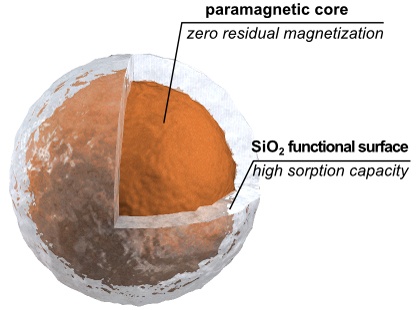
Magnetic nanoparticles are interesting little tools. They are not magnetic themselves, butmagnets can control them. They are deemed safe for use in biological and medical applications, but they have a seemingly mysterious ability to “bind” to “anything” a scientist or doctor wants them to. They can isolate cells and DNA, destroy tumors, and deliver drugs to specific cells or tissues. How can all of this be so? As with most things, the answers to these mysterious properties can be found by examining the way magnetic nanoparticles are constructed.

The American Association for Clinical Chemistry (AACC) is holding its annual meeting in Atlanta, Georgia this year from Sunday, July 26th until Thursday, July 30th. The meeting is composed of two parts: the annual meeting conference and the clinical lab expo.
The annual meeting conference contains mini-tracks focusing work into eight areas of laboratory medicine practice, plenary sessions, symposia, brown bag sessions, and opportunities to speak with experts in the field. The clinical lab expo features representatives from more than 700 laboratory products and services companies. The representatives will have equipment on display to demonstrate the newest breakthroughs and improvements to their products. They will also be able to field any questions that may arise. Bryan Rittenberry of SEPMAG will be found at booth #4714 of our partner PERCORSO LIFE SCIENCES. Stop by and take a look at SEPMAG’s newest products!
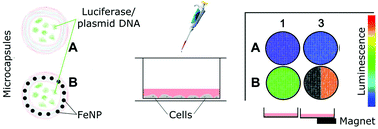
Layer-by-layer microcapsules are composed of alternating layers of oppositely charged molecules. These microstructures are beneficial for use in nanomedicine because they can be easily modified. For example, the different layers can be tuned to carry the necessary bioactive molecules while also targetinga desired tissue and triggering incorporation of the bioactive molecule into the cell.

When a magnetic field gradient is applied to a solution containing magnetic particles, aggregates of magnetic particles will separate out of the solution faster than individual magnetic beads. The increased speed is due to an increased magnetic moment as the beads gather and influence the magnetization of those nearby, and also due to a decreased drag force if the beads form chains. Therefore, it could be beneficial to attach a polymer to the surface of the magnetic beads that would help with aggregation.
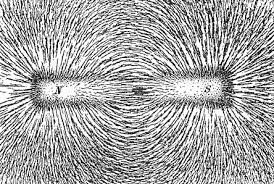
Sepmagrecently connected with a new audience by publishing an article with theonline Oxford magazine Bang! Science.
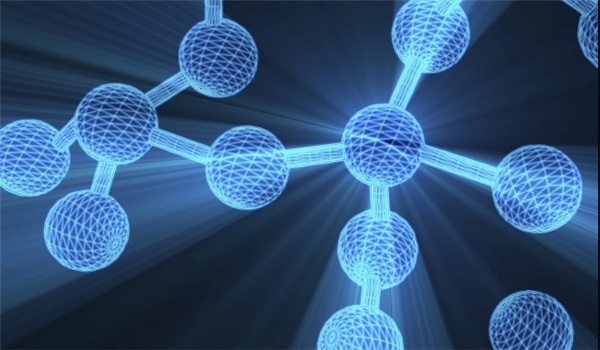
A group of Iranian researchers have created a specialized biomagnetic sorbent using technology, which can be used to remove metallic ions from water with a view to being able to separate pollutants from the liquid and extract them.
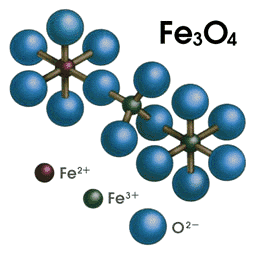
Superparamagnetic iron oxide nanoparticles (SPIONs) are used widely in both research and clinical realms for magnetic separation, isolation, drug delivery, cancer therapy, and imaging. It is important to examine how these particles change during storage in order to ensure accuracy and consistency. A recent study of particles stored for 12 weeks at temperatures ranging from 4°C to 45°C indicates that the particles significantly change in composition and biocompatibility over time, and that a storage temperature of 4°C allows the smallest magnitude of change.
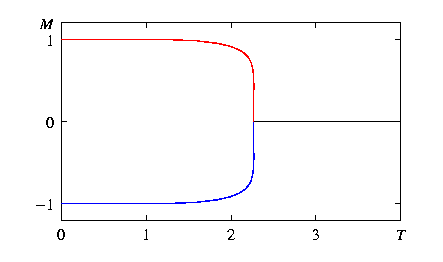
Through a statistical mechanism lens, magnetism can be explained by a lattice of binary spins that can range from a completely random arrangement to total alignment. The percentage of alignment determines the magnetization of the material. These spins are typically denoted as up (+1) or down (-1), and the energy states of the system are defined by an equation involving the spin values, the applied magnetic field, and the interaction strength between neighboring spins. These energy states can be averaged to calculate a total energy or magnetization of the system. Exact mathematical solutions have been defined for the first and second dimensions, but the third dimension continues to elude mathematicians. However, computer simulation makes it possible to model the behavior of magnets in any dimension in various applied magnetic fields at different temperatures.
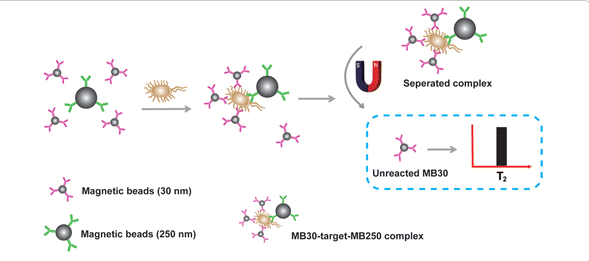
In an attempt to improve upon current options for detecting pathogens and viruses, scientists in Beijing, China have created a new method that employs a combination of magnetic separation (MS) and magnetic relaxation switching (MRS). This new MS-MRS sensor is more rapid and portable than previous methods such as ELISA and PCR.
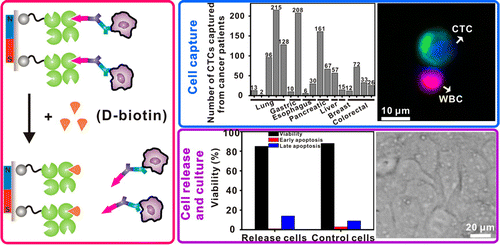
Circulating tumor cells or CTC's are becoming an important target for early diagnosis of cancer. These cells leave the site of a primary or secondary tumor, circulate through the blood, and can potentially lead to metastasis. If doctors are able to detect these cells early it may be possible to stop the spread of cancer before it takes hold. In order to realize this idea it is necessary to capture these cells and keep them viable for in vitro cultures in order to understand gene expression, growth patterns, and catalog identifying surface markers.
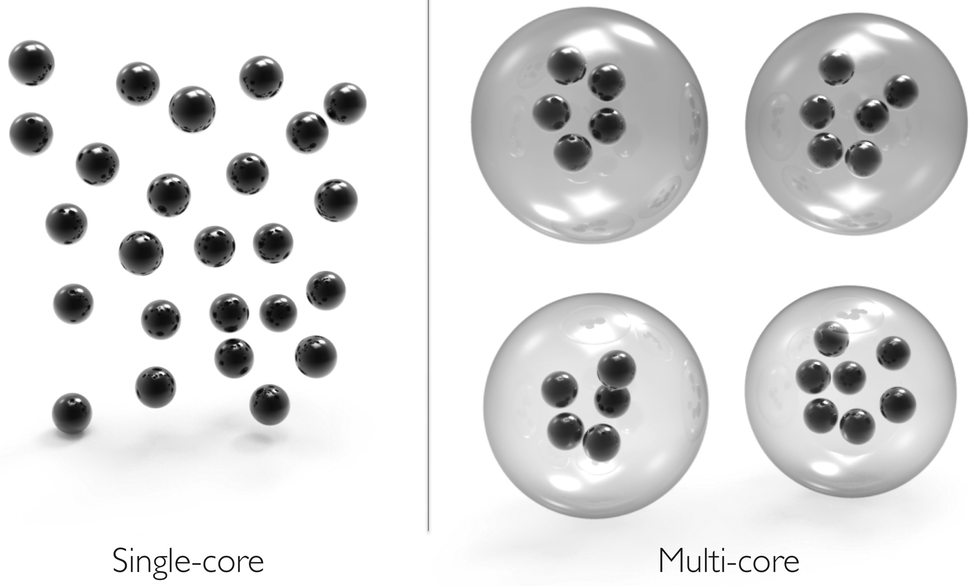
Iron-oxide nanoparticles are widely used in isolation techniques, diagnostics, and therapeutic treatments. This large range of applications naturally introduces variability in the way the particles are used and in desired properties and behavior. Luckily, iron-oxide nanoparticles are not all made alike, and one can select nanoparticles based on size, coating, aggregation tendencies, and behavior in magnetic fields. These properties are determined by synthesis methods.
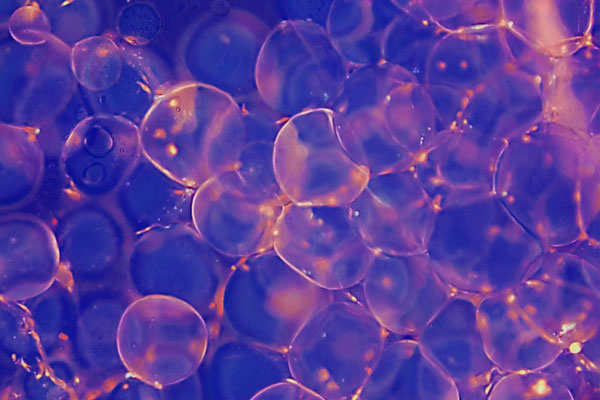
Human adipose-derived stem cells (hASCs) are multipotent cells that can proliferate rapidly and are able to follow a variety of differentiation pathways including adipogenesis, chondrogenesis, osteogenesis, or myogenesis depending on environmental cues.
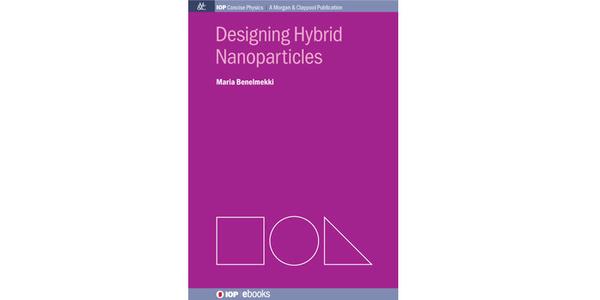
The Institute of Physics (IOP) has just released a new book of the series IOP-Concise-Physics. ‘Designing Hybrid Nanoparticles’ provides a new insight into one of the most promising 'bottom-up' techniques, the modified magnetron-sputtering-based inert-gas-condensation (MS-IGC) system. The book, authored by Dr. Maria Benelmekki, SEPMAG’s scientific advisor, starts with an introduction to nanoparticles and nanotechnology. The chapter providesinteresting examples of their use to obtain different end-products –not just state-of-the art, but also looking back until classical times-. The most relevant of the chapter is the proposed classification of the nanoparticles based on their dimension, morphology and chemical composition. For the people interested on magnetic application, it isworthy to pay attention to the discussion on nanoparticle uniformity and agglomerations.
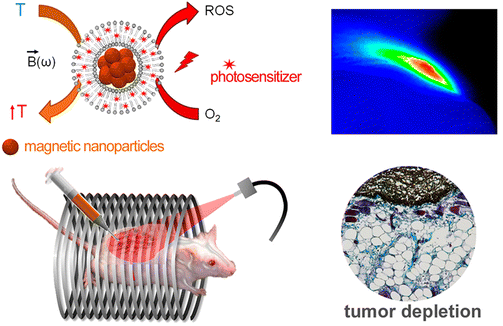
Scientists in Paris, France have engineered liposomes containing iron-oxide nanoparticles and photosensitizers, and have used them to ablate cancerous tumors in mice. While current experimental cancer treatments employ either magnetic hyperthermia techniques or photodynamic therapy, this work is a new attempt to combine the two techniques into one self-contained injectable vessel. Liposomes are spherical, self-assembling, lipid bilayer structures. In the lowest energy state the hydrophobic tails touch inside the bilayer, which forms a sphere with a hydrophilic outer shell and a hydrophilic inner cage useful for carrying drugs, or in this case iron-oxide nanoparticles.

Leading physicists and materials scientists from around the world will be migrating to Barcelona, Spain this July to discuss their newest and most exciting work with like-minded colleagues. The week-long conference will feature plenary and semi-plenary lectures, symposia, oral presentations, poster sessions, and plenty of opportunities for scientists to discuss their current research, find inspiration or answers, and spark ideas for future work.
In June of 2014, a group in Dublin, Ireland created a novel assay to detect Herpes Simplex Virus-1 (HSV-1) using magnetic separation and flow cytometry. Previous methods of detection relied on cell culture, polymerase chain reaction, enzyme immunoassay, or fluorescent antibody diagnostics. Those methods, while quite effective, are time consuming and require a full laboratory. Magnetic separation takes seconds, and the emergence of portable flow cytometry systems makes this new assay feasible for use in the field.
Many bioengineering laboratories are actively researching how to produce synthetic or natural scaffolds seeded with human mesenchymal stem cells (MSCs). The aim of this work is to implant the structures into diseased or damaged sites and encourage healing by introducing a healthy pluripotent cell population on an anatomically correct form. Current research is particularly focused on including small molecules within the scaffold in order to steer MSCs to differentiate to a desired cell type. The number of possible combinations of scaffold material, biomolecular cues, and fabrication methods is vast and holds a lot of therapeutic potential.
Percutaneous transluminal angioplasty is a common procedure to clear blocked arteries. This is often accomplished by inserting a balloon catheter. At the site of the blockage the balloon is inflated and pushes against the arterial wall for a few minutes before being removed. In many cases this is sufficient to open the artery. However, the balloon often damages the arterial wall and it is important that the endothelium repairs itself quickly in order to prevent blood clots and excessive proliferation of smooth muscle (hyperplasia). A common method to stimulate endothelial growth is to introduce vascular endothelial growth factor (VEGF) locally or through the bloodstream. Unfortunately, the half-life of VEGF is short and the large amount needed for efficacy is expensive. This motivated researchers from the Harbin Medical University in the Heilongjiang Province of China to develop a way to locally deliver the VEGF gene to the site of a ballon-injured artery.
Researchers at the Shanghai Key Laboratory of Tuberculosis have improved upon a tool for detecting mycobacterium tuberculosis (MTB) in human samples of deep-lung mucus. The tool combines magnetic, fluorescent, and immunologic sorting techniques to increase test sensitivity and portability. Tuberculosis-specific antibodies and proteins are conjugated to the surfaces of quantum dots (QDs) and magnetic microspheres (MMSs). In this functionalized state the quantum dots and microspheres can freely bind to the mycobacterium. At optimal concentrations, along with sufficient incubation time, the QDs and MMSs each serve as a slice of bread in a QD-MTP-MMS sandwich. The sample is magnetically sorted to collect the MMSs before quantifying the amount of QD fluorescence with a spectrofluorometer.
Bioengineers at the University of California, Los Angeles have developed a new technique for patterning magnetic material onto polydimethyl-siloxane (PDMS), a flexible polymer known as an elastomer. The resulting product has promising biotechnical applications. Its flexibility allows it to conform to many different shapes, and its magnetic field can be tuned by the application of an external magnet.

